WBA WISCONSIN
ECONOMIC REPORT
Read what’s in store for the 2023 Wisconsin economy in this issue of Wisconsin Banker
The Wisconsin Economic Report on pgs. 17–24 features sector forecasts from industry leaders in agriculture, banking, business/ manufacturing, construction, grocery, health care, housing, and technology.

WBA

Kalahari Resort & Convention Center Wisconsin Dells
Bank Executives CONFERENCE
February 8–10, 2023
The Wisconsin Bankers Association (WBA) is excited to announce that the annual Bank Executives Conference will reconvene at the Kalahari Convention Center in Wisconsin Dells this February 8–10. As the largest gathering of
bank leaders in the state, this year’s event will focus on bringing leaders “All In” for the benefit of their bank, community members, and industry.
» Executive-Level Education
Each year, WBA’s Bank Executives
Conference is regarded as the state’s premier gathering of banking professionals and national experts — the 2023 event will be no different! In combining programming tailored to the specific needs of banking leaders in Wisconsin
with various trending topics sure to impact our industry, bankers will have the opportunity to arm themselves with the resources and knowledge to remain relevant and resilient for years to come.
(continued on p. 16)
Banks Serve Communities with Invisible Credit in an Effort to Develop Financially Capable Consumers
By Hannah Flanders
Throughout the United States, millions of Americans are left out of mainstream financial services due to their credit score, or lack thereof. As financial inclusion — with particular emphasis on providing the underbanked access, expanding opportunities for all, and eliminating barriers — becomes increasingly more critical in ensuring every consumer has

the possibility to gain wealth, it is equally as

important that banks understand the unique
Notice…
challenges these individuals face and how they can best be served.
What Does it Mean to be Credit Invisible?
According to information compiled by Oliver Wyman based on data by Experian and previous Consumer Financial Protection Bureau (CFPB) research, around 28 million American adults are credit invisible. Additionally, 21 million adults

(continued on p. 26)
This January/February 2023 issue is the start of the bimonthly production of the Wisconsin Banker newsletter. The six combined issues are: January/February, March/April, May/June, July/August, September/October, and November/December.
Timely, relevant, and up-to-date news, articles, and resources are posted online at wisbank.com and published in the Wisconsin Banker Daily, the Association’s digital e-newsletter.
PRSRT STD U.S. POSTAGE PAID UMS
JAN. | FEB. | 2023 WISCONSIN BANKERS ASSOCIATION FOUNDED 1892
Wisconsin Bankers Association 4721 South Biltmore Lane Madison, WI 53718
This year’s theme brings bank leaders from across the state “All In”
ALL IN
By Daniel J. Peterson
For the last 130 years, the Wisconsin Bankers Association (WBA) has provided banks across our state strength and security in times of challenge, and in turn, thousands of bankers have had the ability to prosper in their careers and equip Wisconsinites for financial success. As our industry continues to evolve, one thing has remained the same — WBA’s mission to advocate for, educate, and support bankers.
In January, I reach the halfway point of my time as chair of the WBA. As I look
back upon all that we have accomplished so far this fiscal year, I anticipate many members will continue to find more opportunities to expand their capabilities through their involvement with our Association.
While the WBA staff does an excellent job working on our behalf, the WBA is a member-driven association that requires input and participation in order to best serve each of
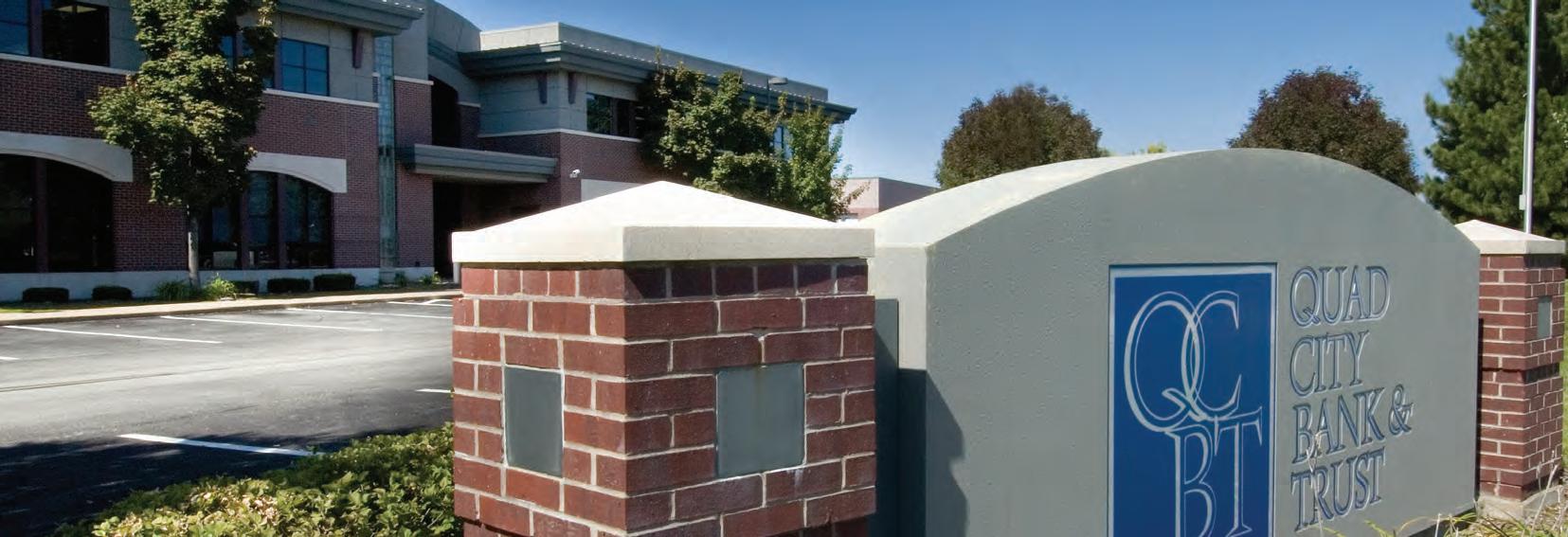
its members. Our success as an organization is not possible without you!
This fiscal year, our Association has prioritized engagement in order to foster the continued growth of Wisconsin’s banking industry. Between new, high-quality, and relevant programming and resources such as the recently formed diversity, equity, and inclusion (DEI) employee resource group (ERG), Wisconsin bankers of all experience levels have the opportunity through their membership to gain valuable knowledge and connections unlike anywhere else.
This year, I encourage bankers to find something that is of interest to them. Whether it be taking part in the hundreds of educational programs offered each year for the benefit of your professional
development; joining a committee, section, or Connect group to share your perspective and meet peers; or volunteering to advocate for our industry as an Advocacy Officer — the opportunities to make the most of your membership this year are vast!
Thank you all for your continued support of our Association and helping us to successfully shape our industry for the benefit of all banks and the communities they serve.
I look forward to working alongside each of you this year to continue to develop our teams, expand our connections, and make 2023 another successful year for Wisconsin’s banking industry.
Peterson is president and CEO of The Stephenson National Bank & Trust, Marinette, and the 2022–2023 WBA Chair.



New Ways to Engage in 2023
Message from the Chair
» Learn more about the Bank Executives Conference on pgs.1 and 16 of this issue. Visit wisbank.com/BEC to register. To learn more about the various opportunities to engage with WBA, visit wisbank.com/value. FEB. 8–10 2023 Creating meaningful relationships is our culture. From executive management to front-line employees, we live it and believe it every day. As your correspondent partner, and a community bank ourselves, we understand the value community banks bring to the clients we serve. qcbt.com/correspondent-banking 4500 N. Brady Street, Davenport, Iowa At Quad City Bank & Trust Isn’t Just a Buzz Word. RELATIONSHIP Sarah Dolan 773.354.4837 Kevin Volker 608.213.4987 2 JAN. | FEB. | 2023
Daniel J. Peterson




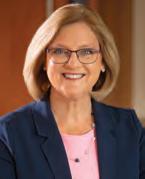


Commercial & ag participation loans Bank stock & ownership loans Bank building financing Business & personal loans for bankers Leverage our large lending capacity, up to $20 million on correspondent loans. Our lending limits are high enough to accommodate what you need, when you need it. Why choose Bell as your bank’s lending partner? Call me at 608.234.1438 Denise Bunbury Together, let’s make it happen. Based in Eau Claire, Wis., serving Wisconsin, Illinois and the Upper Peninsula of Michigan Member FDIC 33787 We do not reparticipate any loans. Callie Schlieman 701.433.7430 Based in Fargo, N.D., specializing in bank stock and Regulation O lending Craig McCandless 406.850.3790 Based in Billings, Mont., serving Montana, Wyoming and Idaho Todd Holzwarth 605.321.9197 Based in Sioux Falls, S.D., serving South and North Dakota, Northwest Iowa and Southwest Minnesota Mary Voss 515.577.0070 Based in Des Moines, Iowa, serving Iowa and Illinois Tracy Peterson 480.259.8280 Based in Phoenix, Ariz., serving Arizona and Colorado Mike Pate 402.301.3707 Based in Omaha, Neb., serving Nebraska JAN. | FEB. | 2023 3










6.
IS YOUR BANK SUFFERING UNREALIZED SECURITY PORTFOLIO LOSSES? ARE YOU IN NEED OF A CAPITAL INJECTION? Bank Stock and Bank Holding Company Stock Loans up to $50 Million Done the Simple Way 4 JAN. | FEB. | 2023
»Call Rick Gerber or Ryan Gerber at 1-866-282-3501 or email rickg@chippewavalleybank.com ryang@chippewavalleybank.com 1. Calling us is the first step. 2. You email us the appropriate documents of information. 3. CVB preparing the loan documents generally within 5 to 10 days. 4. Meeting the customer. We will come to you to sign loan documents. 5. CVB wires the funds.
Wow that was easy.
Name and Signature Inconsistency in Documentation
Banks should consider document type, purpose, relevant issues
By Scott Birrenkott What Name Should Banks
QUse for Customers When Completing Documents?
Compliance Q&A
Visit the compliance section of the WBA website at wisbank. com/resources/compliance
documentation, and the signature itself.
A
Answer: The name that should appear, and be signed, on documents depends on a few things. Primarily, the type of documents being signed, the purpose for which the customer’s name is appearing, and any relevant rules.
Typically, a customer has a single, consistent name which will appear on documents, disclosures, and other communications and match their signature. However, there are situations where this is not the case. A customer might use inconsistent capitalization, or go by different names, such as a “nickname,” or perhaps use their middle initial in some situations, or a “Jr.” or “Sr.” designation. There may also be situations where a customer changes their name, either because of a marriage, or other situation — such as a change in identity or gender transition — and a change from an individual’s “deadname.”
Scott Birrenkott
Banks should consider how various types of documentation can be affected. For example, if opening a checking account, the specimen signature is important to verifying transactions on the account.
If a customer provides a specimen signature which does not match the signature they intend to use on checks, that can result in a question as to whether certain items are authorized. For this reason, the signature card should match the name the customer intends to use when authorizing transactions and should be updated if a change occurs.
When entering into a contract, best practice would be using the customer’s legal name, as provided by customer. The customer should sign in a manner by which they intend to
be bound. There are no specific standards for a signature, other than that it reflects the party’s intent to be bound. For example, a customer might sign in a manner different from the way their name otherwise appears on documentation, such as whether they use a middle initial in their signature or not. Or how they capitalize their signature, or whether they are able to sign their name at all and perhaps can only make a mark or symbol such as a checkmark or “X.”
Banks must consider whether the documents properly identify its customer, and whether the signature affixed to the document reflects a valid contract. In this regard, it is ultimately a matter of policy and preference, but a best practice recommendation would be for the bank to be consistent in how the name appears throughout all the
However, when it comes to Uniform Commercial Code (UCC) financing statements, there are specific rules which must be followed. This article does not delve into the specifics, but banks should consider that for filing UCC financing statements, the filing should reflect the debtor’s exact name as required by Wis. Stat. section 409.503.
For any questions regarding customer names, accuracy of UCC financing statements, or other topics, contact WBA legal at wbalegal@ wisbank.com or 608-441-1200. Additional compliance resources can be found at wisbank.com/resources/ compliance
Birrenkott is WBA director – legal. For legal questions, please email wbalegal@wisbank.com.

Note: The above information is not intended to provide legal advice; rather, it is intended to provide general information about banking issues. Consult your institution’s attorney for specific legal advice or assistance.
WBA Comments on CFPB’s Request for Information Regarding Refinances and Forbearance
Summary of a recent comment letter below
On November 28, WBA filed comments on the Consumer Financial Protection Bureau’s (CFPB) request for information regarding mortgage refinances and forbearances. The CFPB is considering ways to facilitate mortgage refinances for consumers who would benefit from refinancing, especially
consumers with smaller loan balances, and ways to reduce risks for consumers who experience disruptions in their financial situation that could
View this and previous comment letters filed by WBA at www. wisbank.com/CommentLetters
interfere with their ability to remain current on their mortgage payments.
While WBA supports the overall goal of ensuring that consumers have access to the financial opportunities presented by the housing
finance system, WBA’s comments informed CFPB that no further activity, or rulemaking, is necessary in this area. WBA provided comments evidencing how Wisconsin banks provide effective products and opportunities to borrowers.
For copies of this or other WBA comment letters, please contact the WBA Legal Department at 608-441-1200 or visit www. wisbank.com/CommentLetters
JAN. | FEB. | 2023 5
WBA Compliance Resources Online — WBA’s Legal Team has created a variety of toolkits and resources, ranging from the CFPB’s Section 1071 proposal to unclaimed property dormancy, free for bankers use at wisbank.com/resources/compliance.
Supporting WBA’s Advocacy Infrastructure, a Key to Success
By Lorenzo Cruz
With the fall elections finally behind us, the Wisconsin Bankers Association (WBA) can begin pivoting in preparation for the 2023 legislative session and another round of elections occurring this spring. The passage of a state budget that includes a $6.6B budget surplus will occupy the time of most legislators, the Governor, and state agency heads. A State Supreme Court race and a special election for the 8th State Senate District will keep the candidates busy and usher in another flood of campaign spending.
Advocacy Update
Lorenzo Cruz
With the start of the new year, our Association is kicking off two new initiatives — the WBA Leadership Circle and the Hall of Fame — and making changes to contribution levels for the Silver Triangle Club and Gold Triangle Club.
New Opportunities to Engage
lapel pins, certificates, pens, online recognition, Wisconsin Banker picture recognition, Capitol Day/Conference recognition, and exclusive invitation to special events.
The personal contribution level has been increased from $500 to $1,000 for the Silver Triangle award. Individual bankers can earn the award by contributing $1,000 to any combination of the PAC, ABW, or WBA’s issue advocacy fund. Silver Triangle recipients are honored annually at WBA’s Bank Executives Conference.
to encourage them to help us meet the year-end 2023 goal of raising $300,000 in political donations.
Last year, outside groups shattered the previous record and spent more than $93M on the Governor and other state races, according to the Wisconsin Democracy Campaign. The skyrocketing campaign costs and the increasing need to support pro-banking candidates requires WBA to double down on the financial equation of its advocacy infrastructure.
WBA’s Leadership Circle is for major investors and passionate bankers who are committed to investing and creating a healthy future for member banks and the communities they serve. To join the Leadership Circle at the platinum level, a major investor would need to contribute $3,000 or more annually to Wisbankpac (PAC) and/or Alliance for Bankers Conduit (ABW).
To achieve Hall of Fame designation, a major investor would need an aggregate lifetime investment of $25,000 or more. Leadership Circle and Hall of Fame investors benefits could include:
WBA Advocacy Officer Program
Help shape the future of banking in Wisconsin and provide a leadership experience for one of your bankers by signing up a member of your team to be a WBA Advocacy Officer! You’ll be joining over 100 member banks that have already named someone.
Learn more or sign up to become an Advocacy Officer at wisbank.com/advocacy/advocacy-officers to get your name or the name of someone at your bank on the list and start making a difference today. Or contact WBA’s Lorenzo Cruz at lcruz@wisbank.com if you have questions or want more information about WBA’s Advocacy Officer program.
To receive WBA’s Gold Triangle recognition, the total contribution amounts for banks based on assets have been increased to:
While WBA’s advocacy infrastructure is strong, it is important to build and expand upon it. Last year, our industry faced many legislative threats, from credit unions to credit card swipe fees. These challenges will likely return in 2023 as well as a wide range of other issues like elder fraud, taxation, banking modernization, fair access, trust code, and privacy. Our Association and its members cannot afford to be bystanders while other organized and well-financed groups push legislative solutions that are harmful to banks.
$0–100 M ................... $1,500
$100–250 M $2,000 $250–500 M $3,000 $500–750 M $4,000
$750M–$1 Billion $5,000 $1 Billion+ $7,000
Gold Triangle is the highest level of bank fundraising recognition which can be achieved by employees contributing to the PAC or conduit or through corporate contributions to WBA’s issue advocacy fund.
Looking Ahead
As we transition into 2023, it is critical that bankers join forces with the Government Relations team to replenish the depleted coffers for the PAC, conduit, and issue funds. Growing the funds allows us to support pro-banking elected officials and provides a seat at the table for those able to positively shape and influence legislation and rules impacting the industry. WBA urges Advocacy Officers to meet with bank employees
While WBA is taking a proactive lead to ensure that public policies adopted are beneficial to the industry, it is critical to enlist the help of bank leaders to expand the base by designating an Advocacy Officer if they have not already done so.
Moreover, WBA’s Government Relations team calls upon all bank executives, Advocacy Officers, and bankers to step up and answer the call to support WBA’s advocacy infrastructure by joining the Leadership Circle, being a Hall of Fame member, becoming a Silver Triangle member, and achieving Gold Triangle and BIGG recognition.
Now more than ever is the time to unify behind strengthening and expanding WBA’s advocacy infrastructure. The political stakes are high, but together we can function as one united voice amplifying WBA’s priorities at the State Capitol while protecting the interests of member banks doing business in Wisconsin.
Cruz is WBA vice president – government relations.
 » See the 2022 Gold Triangle Club members and 2022 BIGG Award winners on p. 7. Both groups, along with the Silver Triangle Club, will be recognized at the WBA Bank Executives Conference in February.
Bank Assets Total Banker Contributions
GOLD TRIANGLE CLUB LEVELS
» See the 2022 Gold Triangle Club members and 2022 BIGG Award winners on p. 7. Both groups, along with the Silver Triangle Club, will be recognized at the WBA Bank Executives Conference in February.
Bank Assets Total Banker Contributions
GOLD TRIANGLE CLUB LEVELS
6 JAN. | FEB. | 2023
Gold Triangle Club
» Bank employee or director personal contributions to Alliance of Bankers for Wisconsin (ABW) political conduit;
— the highest level of fundraising recognition for banks is achieved through:
» Bank employee or director personal contributions to Wisbankpac; or
» Corporate contributions to WBA’s issue advocacy fund.
Thank you, 2022 WBA Gold Triangle Club Members! (WBA Gold Triangle Club as of 12/15/22.)
American National Bank –Fox Cities, Appleton
Associated Bank, Green Bay Bank Five Nine, Oconomowoc Bank of Brodhead Bank of Sun Prairie Bank of Wisconsin Dells Bankers’ Bank, Madison Bluff View Bank, Galesville Bristol Morgan Bank, Oakfield Capitol Bank, Madison Charter Bank, Eau Claire Citizens Bank, Mukwonago Citizens First Bank, Viroqua Citizens State Bank of Loyal East Wisconsin Savings Bank, Kaukauna
The Equitable Bank, Wauwatosa First Citizens State Bank, Whitewater
Fortifi Bank, Berlin
Forward Bank, Marshfield Greenwoods State Bank, Lake Mills
Horicon Bank
Mound City Bank, Platteville National Bank of Commerce, Superior
National Exchange Bank & Trust, Fond du Lac
Nicolet National Bank, Green Bay
North Shore Bank, Brookfield Oak Bank, Fitchburg
Old National Bank, Evansville, Ind.
Oostburg State Bank
The Park Bank, Madison
The Peoples Community Bank, Mazomanie
Peoples State Bank, Prairie du Chien
Premier Community Bank, Marion Security Financial Bank, Durand State Bank of Cross Plains
The Stephenson National Bank & Trust, Marinette Superior Savings Bank Town Bank N.A., Hartland
Bank Assets (2022 criteria)
Unity Bank, Augusta Waldo State Bank Wisconsin Bankers Association, Madison
Wolf River Community Bank, Hortonville
$0–$25 Million $500 $25–100 Million $1,000 $100–$250 Million $1,500 $250–$500 Million $2,000 $500–$750 Million $2,500
$750 Million–$1 Billion $3,500 $1 Billion+ $4,500
BIGG Award
(Bankers Involved in Grassroots and Government)
Five of the following seven criteria must be met for an institution to achieve BIGG Award status:
»Have named a WBA Advocacy Officer.
»Obtained a Gold Triangle Club Award.
»Contributed to WBA’s Issue Advocacy Fund.
»Have at least one bank employee attend WBA Capitol Day.
American National Bank –Fox Cities, Appleton
Associated Bank, Green Bay Bank Five Nine, Oconomowoc Bank of Brodhead Bank of Sun Prairie Bank of Wisconsin Dells Banker’s’ Bank, Madison Bristol Morgan Bank, Oakfield
»Have a member of the bank participate in a Federal delegation meeting or attend a Washington, D.C. regulatory trip.
»Have the bank host a Take Your Legislator to Work Day.
»Other (e.g. testify on a bill, host a fundraiser, analyze legislation, etc.).
Congratulations to the 2022 WBA BIGG Award Winners!
Citizens First Bank, Viroqua
East Wisconsin Savings Bank, Kaukauna
First Business Bank, Madison
Fortifi Bank, Berlin Greenwoods State Bank, Lake Mills
Mound City Bank, Platteville
National Exchange Bank & Trust, Fond du Lac
North Shore Bank, Brookfield Oostburg State Bank
The Park Bank, Madison The Peoples Community Bank, Mazomanie Royal Bank, Elroy
Security Financial Bank, Durand State Bank of Cross Plains
The Stephenson National Bank & Trust, Marinette
Town Bank N.A., Hartland Waldo State Bank
Wolf River Community Bank, Hortonville
» To donate: visit wisbank.com/give. To learn more or for more information: please visit wisbank.com/advocacy or contact WBA Vice President – Government Relations Lorenzo Cruz at 608-441-1206 or lcruz@wisbank.com
JAN. | FEB. | 2023 7
TOTAL BANKER PERSONAL CONTRIBUTIONS
WBF Offers Free Kits for Teach Children to Save Day
Reading Raises Interest Kits available
starting January
16


Every year, bankers from around the state of Wisconsin join forces in teaching the importance of saving and spending wisely to the youngest members of their communities. In conjunction with WBA’s Power of Community Week, April 17–22, and National Teach
» Are you planning to participate in any financial education presentations this spring? Make sure to highlight these achievements by filling out the form at wisbankfoundation.org/ financial-education-awards.
» Additional financial education resources can be found at wisbankfoundation.org/ resources

Children to Save Day on April 27, the Wisconsin Bankers Foundation (WBF) provides free Reading Raises Interest Kits to WBAmember banks at their request.
This year’s kit features Margret and H. A. Rey’s Curious George Saves His Pennies. As part of the kit, bankers are provided with a guide on how to plan your presentation and contact local schools, lesson plans created
by the St. Louis Fed and the Consumer Financial Bureau (CFPB), a take home handout, and 25 copies of the book. Banks are welcome to order more copies of the book for a small fee. Additionally, online resources, sample letters, and news releases are available at wisbank foundation.org/reading-raisesinterest-kits
Lessons as part of the 2023 kit are appropriate for engaging students in Grades K–2 (ages 5+) in the concepts of saving money. However, additional resources, book suggestions, and financial education materials for different ages can also be found by visiting the Foundation’s website, wisbankfoundation. org/resources.
» Order your free Reading Raises Interest Kit before March 1 at wisbank foundation.org/readingraises-interest-kits.
The Foundation is excited to continue its tradition of assisting members in spreading the word on the importance of financial literacy throughout their communities. Orders for the 2023 kit are due March 1 in order to be delivered in time for National Teach Children to Save Day.
Contact WBA’s Hannah Flanders at 608-441-1237 or hflanders@wisbank.com for more information.
8 JAN. | FEB. | 2023
Wisconsin Bankers Foundation Offers Scholarships to Local Students
Spring scholarship application period begins January 30
The Wisconsin Bankers Foundation (WBF) will begin accepting applications for the 2023 Spring Scholarship on January 30. This opportunity is open to graduating seniors currently attending a Wisconsin high school who are planning to continue their education at a Wisconsin school, adults returning to college, or current college students attending an accredited Wisconsin college, university, or technical college.
» Apply at wisbankfoundation. org/scholarships.
Four (4) awards of $2,000 each will be presented to selected applicants who submit a completed application no later than March 15. Qualifying applicants will be required to demonstrate their financial literacy, their scholastic achievement and
community involvement, and their confirmed enrollment for the fall 2023 semester An interest in pursuing a career in the financial services is encouraged, but not required. Completed applications must be submitted by March 15 at wisbankfoundation.org/ scholarships. Bankers are encouraged to share this opportunity widely within their communities — please consider reaching out to local educators and team members who are, or may know of, a qualifying applicant, and college students
throughout the state — to assist the Foundation in its pursuit to increase the financial capabilities of Wisconsinites. To learn more or apply for the annual scholarship, visit wisbankfoundation.org/ scholarships
» WBF’s annual Spring Scholarship is a great opportunity for graduating seniors, current college students, and adults returning to school to save money! Applications are open January 30–March 15
Gearing Up for Power of Community Week, April 17–22
Every year, bankers, WBA Associate Members, and WBA staff look forward to getting out into their communities for a week that shows our collective impact in a meaningful way. While we know that the banking industry is committed to serving Wisconsin communities throughout the year, the Power of Community Week is a major highlight that demonstrates to the public our ongoing commitment to those local communities.
The 2023 WBA Power of Community Week will take place April 17–22, 2023 and will be followed by National Teach Children to Save Day on April 27, 2023. Activities in late April and early May still count toward a bank’s participation in the WBA Power of Community Week. Examples of participation in the WBA Power of Community Week include volunteering at nursing homes, hosting shredding events at the bank, running a food drive, or giving
financial literacy presentations in K–12 classrooms (including virtual presentations).
We invite all members to participate in this effort to show how much Wisconsin’s banking industry supports the communities in our state.
Create team spirit by ordering Power of Community t-shirts for your company!
The shirts feature the campaign logo and hashtag (#Banks PowerWI). A company logo may also be added to the back of the t-shirts. Power of
Community T-shirt orders are due March 1, 2023
Visit www.wisbank.com/ BanksPowerWI to »order t-shirts, »designate a Power of Community Week contact for your organization, and »let WBA know about your planned activities, so they can be added to the interactive map of activities statewide.
We look forward to an impactful week of serving the communities we are proud to call home!
The WBA Power of Community campaign brings our member bankers together to celebrate your commitment to the communities you serve. During the week, we encourage all bankers to engage in one or more community service activities.
Commit to participating online at www.wisbank.com/BanksPowerWI
Questions: Please contact WBA Staff at questions@wisbank.com or at 608-441-1200.
JAN. | FEB. | 2023 9
GET INVOLVED DATES: APRIL 17–22, 2023
What is the WBA Power of Community Week?
FIPCO Serves Compliance Concierge® Customers With Software Updates
By Annette Witkowski
Customers have always been, and will always be, top on the minds of FIPCO staff members. That is why we continually revise the Compliance Concierge® software with updated documents, regulation changes, and user enhancement requests.
Some of the items we have released lately are:
» HOEPA/HPM rates, so Compliance Concierge® notifies when users are outside of their range;
» Reg Z threshold amount, so Truth-in-Lending documents appear when required;
Software Support/Training
Annette Witkowski
» Bank holidays that allow Compliance Concierge® to calculate rescission;
» Over 40 secondary market documents that the GSEs have changed;
» Updated Ascensus* IRA documents;
» fipco.com
» User-requested warning messages on certain screens;
» Factual Data by CBC interface;
» Revisions to WBA 382 P.O.D. Beneficiary Designation document;
» User-requested commercial application document; and
About FIPCO… Founded in 1987, FIPCO (a WBA subsidiary) helps financial institutions stay compliant in a fast-changing regulatory environment. Our form sets are regarded as the industry standard. Our Compliance Concierge™ loan, mortgage, and deposit software solutions are developed and supported with a meticulous approach to compliance. Our software solutions expand to include ConnectFI cloud-based online lending software, cybersecurity solutions, and more! FIPCO also offers valuable consulting services, including risk management, IT auditing, and ShareFI compliance and management services. Learn more at fipco.com

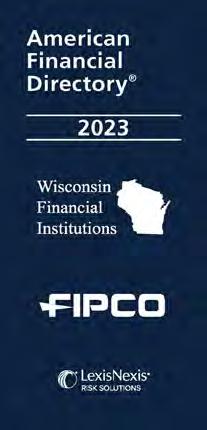
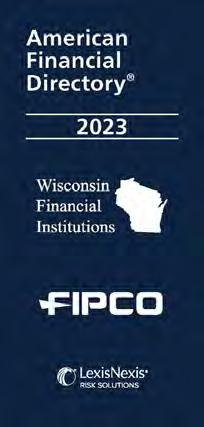
» Updated Automatic Payment Authorization to comply with NACHA rules.
We continue to distribute timely information through software release notes, notices, and the monthly FIPCO Focus e-publication. If you are not receiving these items and would like to, please visit fipco.com and edit your profile or, if you are not registered with our website, click “Sign Up” to request these items.
As always, FIPCO staff members are here for you. If there is anything we can help with, please contact our business development team at fipcosales@fipco.com or fipcosupport@fipco.com
Witkowski is director – software training and support services for FIPCO, a WBA Gold Associate Member.

Ascensus is a WBA Associate Member.
New Associate Member Service
Available for WBA Members
The WBA has approved the following service provider as a new WBA Associate Member.
Wisconsin School of Business Center for Professional & Executive Development www.uwcped.org Contact: Trinity Korth Madison, WI 53715 Tel: 920-707-3442 trinity.korth@uwcped.org
The Wisconsin School of Business Center for Professional & Executive Development helps individuals and organizations move forward. More than 70 professional development
For more information, please contact WBA at sales@wisbank. com or visit www.wisbank.com
programs are delivered annually on-site and online by instructors with practical, real-world experience. The Center for Professional & Executive Development also provides custom development solutions and consulting services to organizations of all sizes including the financial services industry.
WBA Associate membership should not be construed as an endorsement of the company’s products or services by the WBA.
Did You Know… You can purchase sponsored content space in Wisconsin Banker Daily, the
letter? Please contact
or
or
for more information. –Wisconsin Edition –2023 American Financial Directory This annual bank directory has the most current Wisconsin financial institution information, including every depository institution and branch by city. The handy (4.5” x 9”) size includes more than 200 directory pages. Information for every Wisconsin depository institution and branch by city. WBA Members: $145 each Non-Members: $170 each To place your order: order@fipco.com 800.722.3498 www.fipco.com 10 JAN. | FEB. | 2023
Association’s daily news-
WBA’s Nick Loppnow at 608-441-1259
nloppnow@wisbank.com
email sales@wisbank.com
FIPCO
WBA COMMITTEES
WBA’s committees and advisory boards help shape the industry by supplying fresh ideas, expert insight, and valuable networking connections
&COMMITTEES, SECTION BOARDS
• Please visit www.wisbank.com/ community/get-involved to download the nomination form.
•
Get Involved, Make a Difference
to key decisions the Association is involved with.
If you have a desire to influence your industry’s future, consider lending your
experience on one of the committees listed below, and find out for yourself how much you can impact Wisconsin’s financial
> WBA Agricultural Bankers Section Board
> WBA BOLT Section Board
> WBA Diversity, Equity, and Inclusion Advisory Group
> WBA Financial Crimes Committee
> WBF (Wisconsin Bankers Foundation) Financial Literacy Advisory Board
> FIPCO® Software Users’ Committee
Congratulations, Graduates!
services industry.
To volunteer, please fill out the committee nomination form found at www.wisbank. com/community/get-involved.
> WBA Government Relations Committee
> WBA Human Resources Committee
> WBA Marketing Committee
> WBA Mortgage Lending Committee
> WBA Retail Banking Committee
> WBA Technology and Operations Committee

> WBA Trust Banking Section Board
BankWork$ Milwaukee Training Program for Bankers
The November BankWork$ class has graduated!
The Wisconsin Bankers Association (WBA) is proud to partner with Employ Milwaukee to bring this nationwide program to Wisconsin. BankWork$ is a free, eight-week training program to prepare participants in primarily underserved neighborhoods for retail banking careers.
The graduating class of 13 included: Jeaneams
Calderon, Diondra Cheese, Jonathan Chestnut, Smita Inamdar, Joseph Lacey, Maiue Lee, Negeli Nsabaka, Kimberly Peoples, Josefina Rauda De Stetzer, Aaliyah Sanders, Fatuma Shale, Amy Sundberg, and
Thank you to the following banks for sponsoring the BankWork$ program:
» Learn more about the BankWork$ program at employmilwaukee.org/EmployMilwaukee/Programs--Services/Adult-Youth-Programs/BankWork.htm
Jose Valdehuesa. WBA’s Daryll Lund attended the ceremony and congratulated the graduates on their achievement.
Over the eight weeks, these students learned the hard and
» Associated Bank, Green Bay
» Bank Five Nine, Oconomowoc
» The Equitable Bank, Wauwatosa
soft skills necessary for entrylevel retail and operations positions. The program began in 2019 with the goal of training individuals for positions in the banking
» First Federal Bank of Wisconsin, Waukesha
» Johnson Financial Group
» Old National Bank, Milwaukee
» November BankWork$ graduates seated (left to right) are: Kimberly Peoples; Jonathan Chestnut; Maiue Lee; and Adriene Wright, BankWork$ Milwaukee instructor. Standing (left to right) are: WBA’s Executive Vice President and Chief of Staff Daryll Lund; Jose Valdehuesa; Joseph Lacey; Josefina Rauda De Stetzer; Diondra Cheese; Aaliyah Sanders; Jeaneams Calderon; Smita Inamdar; Fatuma Shale; Amy Sundberg; Negeli Nsabaka; and Jovo Potkonjak, BankWork$ program manager.
industry. So far, the program has provided over 100 Milwaukee-area residents with the opportunity to pursue a career in the financial services industry.

» PyraMax Bank, Greenfield
» Spring Bank, Brookfield
» Waterstone Bank, Milwaukee
» Wells Fargo
JAN. | FEB. | 2023 11
WBA needs your expertise to help shape the industry’s future
Climate Risk Regulations Will Likely Target Community Banks
By Jeff Gruetzmacher
Community banks have generations of experience managing concentration risks and responding to extreme weather events and natural disasters in their communities. They have long weighed a broad range of risks involved with investing in businesses and asset classes and have employed a range of risk management strategies such as hedging and hazard, crop, flood, and life insurance.
Bankers know their communities and loan portfolios better than anyone else, as evidenced by the absence of community bank failures following severe weather events.
While several federal regulatory agencies are working to finalize proposals on climate-related financial risk management that target
Jeff Gruetzmacher
the nation’s largest financial institutions, the proposals would inevitably subject Wisconsin community banks and the communities they serve to new and expensive regulatory burdens. This new onerous framework is counterproductive and unnecessary.
Climate risk management frameworks proposed by the Federal Deposit Insurance Corporation (FDIC), Office of the Comptroller of the Currency (OCC), and the Federal Reserve Board (FRB) purportedly target banks over
$100 billion in assets, but regulators have publicly signaled the policies will ultimately trickle down to community banks. Regulation creep is real, as evidenced by the Current and Expected Credit Loss (CECL) regulations.
The FDIC recently said in a speech at the American Bankers Association’s (ABA) Annual Convention in October that all financial institutions are subject to climate-related financial risks, while the OCC stated in March of 2022 that their examiners will conduct climate risk management examinations on community banks in the coming years. Regulators have made their intentions clear: community banks will not get a pass.
endless and costly rabbit holes that community banks will be forced to go down in an effort to play infinite what-if games.
Community banks could also be forced to pick favorites in industries that are disfavored but legal. Some question if this is a reintroduction of “Operation Choke Point” version 2.0, where the agencies use the financial system to pick winners and losers in industries that Congress itself continues to make legal.
And then let’s talk about costs. Community banks would have to pay a myriad of expenses to comply with climate risk management frameworks — including hiring subject matter and compliance experts to implement these complicated frameworks.
Uncomplicate regulatory compliance
Gain access to Wipfli’s team to help untangle complicated regulatory compliance rules. Learn more at wipfli.com/ComplianceHelp.
The largest conundrum is how community bankers can assess their risks of climate change, without customers first accounting for climate risks themselves? And what resources and costs will be necessary for customers to perform their own climate risk assessment and disclose required greenhouse gas emissions data as a condition of banking? These extra costs will also burden rural communities and citizens.
For example, will a dairy farmer need a methane gas emission report to obtain a loan? Will banking the local gas station be red flagged by regulators? And what about a trucking company using older diesel trucks and not enough electric ones? How risky is banking a manufacturer making artic boots when we might have milder winters?
Finally, overlooked but problematic, is the Securities and Exchange Commission’s (SEC) proposal to institute climate-related investor disclosures, which contains no exemption for community banks. This threatens to impose unprecedented costs and potential liabilities that would drive local institutions out of the public capital markets.
Rather than impose new climate-related rules on community banks, regulators should continue to utilize existing and effective risk management supervision practices that have long been proven and sound.
Perspective changes everything.
Even consumers could be a target of additional oversight and reporting. Will homes financed need to have a renewable energy heating system or efficiency score? The practical questions are limitless.
An open-ended climate risk regulation may give birth to
The conversation shouldn’t be about introducing new regulations — the conversation should be about what community banks will continue to do, as they have for generations, to successfully mitigate all risks, including climate. Additional regulatory frameworks and burdens are simply not needed.
Gruetzmacher is senior vice president and director at Royal Bank, Elroy. He serves on ICBA’s Agriculture — Rural America Committee and is a past chair of the WBA Agricultural Bankers Section Board of Directors
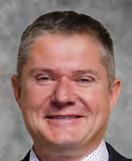
12 JAN. | FEB. | 2023
Guest Column
EDUCATION Calendar
JANUARY 2023
•Midwest Economic Forecast Forum 12 Virtual
•Community Bankers for Compliance (CBC) — Session I 24–25 Virtual half-days; membership (pricing options vary)
FEBRUARY 2023
•Bank Executives Conference 8–10 Wisconsin Dells
•Compliance Forum: Session 3 14 Wisconsin Dells; annual membership (pricing varies)
MARCH 2023
•Call Report Review & Update Workshop 1–2 Virtual half-days; $245/attendee
•Advanced IRA Workshops 7 Madison or virtual; $245/attendee
•Health Savings Accounts Workshops 8 Madison or virtual; $245/attendee
•Loan Compliance School 13–17 Madison or virtual; $1,295/attendee

•Real Estate Compliance School 15–17 Madison or virtual; $795/attendee
•Introduction to Commercial Lending School 20–22 Madison; $895/attendee
•WBA/ABA Washington Summit 20–23 Washington, D.C.
•Security Officer Workshops 22 Wisconsin Dells or virtual; $245/attendee
APRIL 2023
•Principles of Banking Course 5–6 Fond du Lac; $550/attendee 12–13 Mineral Point; $550/attendee
•Residential Mortgage Lending School 11–14 Madison; $1,045/attendee
•Agricultural Bankers Conference 13–14 Wisconsin Dells; $300/ag section member or $350/non-section member attendee
•Power of Community Week 17–22 wisbank.com/BanksPowerWI
APRIL 2023 (continued)
•Compliance Management School 18–20 Madison; $795/attendee
•Women in Banking Conference 25 Wisconsin Dells or virtual; team pricing available
•Community Bankers for Compliance (CBC) — Session II 26 Wisconsin Dells or virtual; membership (pricing options vary)
MAY 2023
•American Mortgage Conference 1–3 South Carolina
•Personal Banker School 2–3 Wausau area; $495/attendee
•HR Conference 4 Stevens Point; $245/attendee
•School of Bank Management 8–12 Madison; $1,395/attendee
•BSA/AML Conference 10–11 Wisconsin Dells; $450/attendee
•Capitol Day 11 Madison
•CFO Conference 17 Madison; $245/attendee
•Directors Summit 18 Madison; $225/attendee
•Trust Conference 25 Madison; $245/attendee
JUNE 2023
•BOLT Summer Leadership Summit 15–16 Wisconsin Dells; $250/attendee
•Compliance Forum: Session 1 TBD Wisconsin Dells; annual membership (pricing varies)
» Visit www.wisbank.com/education for more information and online registration.
» Or email WBA Education at wbaeducation@ wisbank.com or call 608-441-1252.
Conferences I Summits Schools I Boot Camps Seminars I Workshops WBA Webinars Other Events
JAN. | FEB. | 2023 13
Your
Bulletin Board
News about people working in Wisconsin’s financial institutions
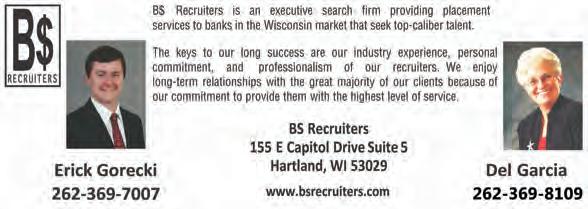
Promotions and New Hires

Fitchburg
Oak Bank is pleased to welcome Cristie Hansen (pictured) to the team as a vice president of deposit operations.


Independence
It is with great pleasure that the Board at Independence State Bank announces the promotion of Rita Hayter (pictured) to executive vice president –organizational development.
Ixonia
Ixonia Bank is pleased to announce that Steve McGuire (pictured) has joined the bank’s commercial banking team as the newest senior vice president of commercial lending.
Madison Bankers’ Bank is pleased to announce the promotions of David Paxton (pictured) to senior vice president – risk management solutions and Jim Kluck (pictured) to first vice president – risk management solutions.
Additionally, the team is excited to welcome Brian Mickey (pictured) as first vice president – risk management solutions.

Manitowoc Bank First is pleased to announce the promotion
of Naji Allan (pictured) to assistant vice president –business banking officer. Additionally, the bank is pleased to welcome Bridget Tally-Brill (pictured) as vice president – retail banking.
Milwaukee
Wintrust Commercial Banking at Town Bank, N.A., the Wisconsin-based commercial banking unit of Wintrust Bank, has promoted Glenn Margraff to executive vice president and head of commercial banking.



New Glarus
The Bank of New Glarus is excited to announce the promotion of Ashley (Frie) Johnson (pictured) to cash management specialist.


(continued on p. 15)
Hudson, Galesville Bankers Honored with Lifetime Service Awards
WBA President and CEO Rose Oswald Poels presented Tom Van Pelt, president and CEO of Citizens State Bank, Hudson, with a WBA Lifetime Service Award in recognition of his 43 years in banking. WBA also congratulated Van Pelt on his recent retirement.

WBA Lifetime Service Awards are awarded to bankers who have served the banking industry for 30 and 40 years. Honorees are recognized throughout the year or at a special ceremony during the WBA Management Conference in September. Visit wisbank.com/ serviceawards to have an individual from your bank recognized.
On November 4,
(40 years); Steve Poss, senior vice president – mortgage lender (32 years); Oswald Poels; and Scott Kopp, chairman of the board (38 years) Congratulations!
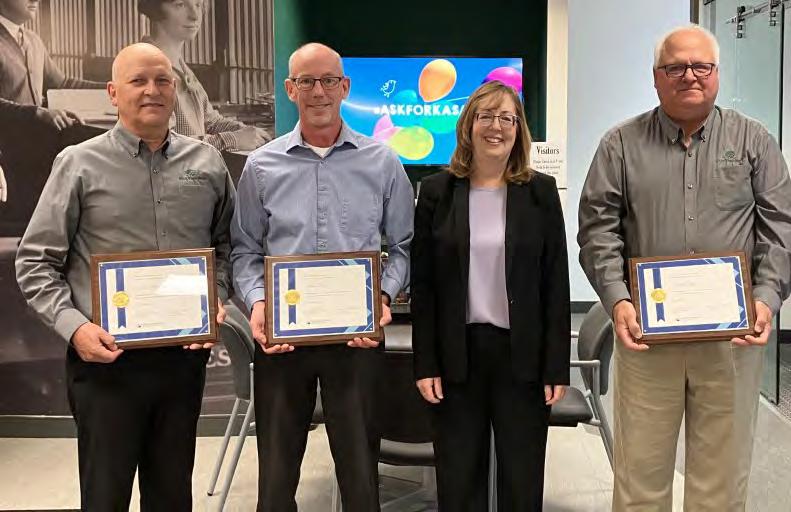 WBA President and CEO Rose Oswald Poels honored three bankers at Bluff View Bank in Galesville for their lifetime of service to the banking industry. Pictured are (left to right): Dan Mueller, senior vice president – commercial & ag loan officer
Hayter
Tally-Brill
McGuire
Mickey
Kluck Hansen Allan
Paxton Johnson
WBA President and CEO Rose Oswald Poels honored three bankers at Bluff View Bank in Galesville for their lifetime of service to the banking industry. Pictured are (left to right): Dan Mueller, senior vice president – commercial & ag loan officer
Hayter
Tally-Brill
McGuire
Mickey
Kluck Hansen Allan
Paxton Johnson
Have good news? To submit a notice, please email
. Or
.
bulletinboard@wisbank.com
mail entries to WBA Bulletin Board, 4721 South Biltmore Lane, Madison, WI 53718. Send photos as JPEG files. Questions? Contact WBA’s Hannah Flanders at 608-441-1237 or hflanders@wisbank.com
14 JAN. | FEB. | 2023
Bulletin Board
News about people working in Wisconsin’s financial institutions
Promotions and New Hires
(continued from p. 14)
Oregon
One Community Bank welcomes Joshua Fager (pictured) to the Middleton location as assistant vice president –bank manager and Brendan Flanagan (pictured) to the Waunakee location as assistant vice president – bank manager.

Retirements
Fond du Lac
National Exchange Bank & Trust congratulates Julie Roth (pictured), former vice president of lending, who recently retired after 31 years of service.


Marion
In November, two longtime Premier Community Bank employees retired. Congratulations to Diane Koepke with 59 years (pictured), former assistant

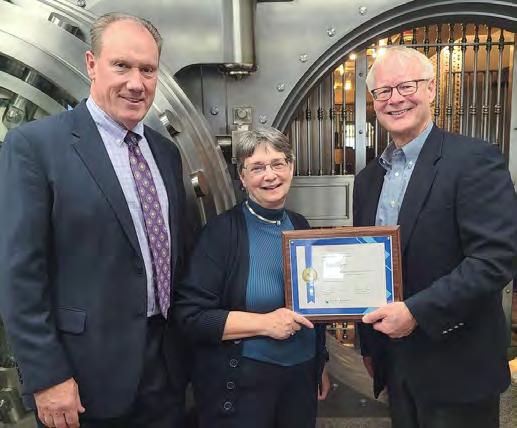

vice president — branch manager of Premier Community Bank’s Tigerton office and to Sam McMahon with 42 years (pictured), former senior vice president of lending. Combined, the two banking veterans hold over 100 years of industry experience.

Waterloo Farmers & Merchants State Bank Accounting Officer and Credit Analyst Tammy

Weisman retired in January after over 23 years in banking.


Congratulations Oregon
One Community Bank is proud to announce that Bill Borchers (pictured), vice president – loan servicing and construction, received the Distinguished Service Award from the Wisconsin Mortgage Bankers Association (WMBA) Madison chapter.
Port Washington
Port Washington State Bank’s Vice President – Branch Manager Heather Mader (pictured) has accepted the 2022 Next Generation Leadership Award from the Mequon-Thiensville Chamber of Commerce.
Additionally, Chanel Schmidt (pictured), assistant vice president — branch manager has accepted the 2022 Volunteer of the Year Award from the Belgium Chamber of Commerce.

Waukesha Lori Hert (pictured), senior personal trust associate at Prairie Trust — a division of Waukesha State Bank, was recently awarded the Certified Trust & Financial Advisor (CTFA) professional certification from the American Bankers Association (ABA).
Honoring Banking Professionals for Years of Dedicated Service
WBA Lifetime Service Awards are awarded to bankers who have served the banking industry for 30 and 40 years. Honorees are recognized throughout the year or at a special ceremony during the WBA Management Conference in September. Visit wisbank.com/serviceawards to have an individual from your bank recognized.
Julie Beyer (center), assistant vice president and risk management officer, The Stephenson National Bank & Trust (SNBT), Marinette recently received a WBA Lifetime Service Award from WBA Executive Vice President and Chief of Staff Daryll Lund (right) in recognition of her 46 years of extraordinary service to Wisconsin’s financial industry. SNBT President and CEO Dan Peterson is pictured on the left.
On November 9, five KeySavings Bank, Wisconsin Rapids employees were awarded WBA Lifetime Service Awards during Bruce W. Rokke’s retirement celebration. Congratulations (left to right): Rokke, CEO (42 years); Richelle A. Coyer, secretary (40 years); Shirley A. Jung, operations officer and assistant secretary (42 years); and Lawrence H. Schmick, chairman (48 years). Not pictured: Todd L. Buntrock, former vice president (honored posthumously for 34 years)
Roth
Schmidt
McMahon Hert
Fager Mader
Koepke
Flanagan
JAN. | FEB. | 2023 15
Borchers
Bank Executives Conference
(continued from p. 1)
This year’s opening general session on February 9 will feature Virginia Heyburn, director of research, insights, and advocacy at Engage fi, LLC. As innovation and technology remain at the forefront of our industry’s efforts to engage individuals in the financial services, Heyburn will highlight the possibilities of FinTech partnerships as banks look to develop new revenue channels and reach customers in today’s world of rapidly changing competition.
New This Year! This year’s conference will feature WBA’s first live FinTech Showcase. Learn how your bank can engage with new solutions during the onehour general session.
After the general session, WBA will host its first FinTech Showcase. Bankers can expect to see eight FinTech products, ranging from solutions for digital banking and artificial intelligence (AI) to security, demonstrated live by various companies including Accrue, La Macchia Group, DocFox Inc., Kapitalwise, Inc., KlariVis, LemonadeLXP, Sequertek, and Zogo Finance. Following short presentations, bankers will have the opportunity to connect with these exhibitors, and more than 60 others, to learn more about their solutions and how FinTech will bring the bank into the future.
On Friday, February 10, four-time bestselling author and renowned futurist, Brett King will present the keynote session “The Big Shift: How Customer Behavior & Technology Will Change

WBA
ALL IN Visit
Bank Executives CONFERENCE
FEBRUARY 8–10, 2023 Kalahari Resort & Convention Center, Wisconsin Dells wisbank.com/BEC
the Future of Retail Financial Service.” King, voted as American Banker’s
King Innovator of the Year in 2012 and a regular contributor to The Huffington Post, will highlight why customer behavior is so rapidly changing and why banks must reinvent themselves or face irrelevancy.
With over ten hours of general and breakout sessions spread across the three days — there will certainly be something of interest for every bank leader. For more details on programming and to view the full agenda, please visit wisbank.com/bec.
» Networking
Attendees will also have various opportunities to connect with their banking peers, WBA Associate Members, and WBA staff throughout the conference.
In addition to kicking off the conference on Wednesday evening with a networking reception in the exhibitor Marketplace, bankers are invited to arrive early on February 8 for various “banker-only” peer group discussions. The optional peer groups, beginning at 2:30 p.m., are specifically targeted at CEOs, CFOs, credit and lending professionals, and those in operations.
» Recognition
WBA looks forward to recognizing various bankers who have been “All In” for their communities and for their industry — despite the unpredictability of the last several years.
In selecting the unifying theme “All In” for this year’s conference, the Association recognizes that the unity and commitment leaders and bankers across the state have, and will continue to, demonstrate are critical to the prosperity of the industry and communities all WBA-member banks serve. In this, it is important that bankers not only reflect upon their successes of the past year but look ahead to what possibilities are in store.
The conference will feature a special luncheon on February 9 during which several bankers who have dedicated a lifetime of service to the industry will be inducted into WBA’s 50- and 60-Year Clubs. In addition, the Wisconsin Banker Foundation (WBF), the Association’s non-profit arm, will present its prestigious Financial Education Innovation Award to a WBA-member bank that, during the 2021–2022 fiscal year, demonstrated unique efforts to enhance the financial capability of consumers in their community.
That evening, WBA will recognize a bank CEO or
Learn more about the event and register now for WBA’s annual Bank Executives Conference at wisbank.com/bec
Topics of Interest
• Fintech and digital transformation
• Digital assets and payments
• Cybersecurity
• Talent recruitment and retention

• Economic pressure
president (or an individual who has recently retired from these positions) who has made an outstanding effort throughout their career in service to their bank, to their community, and to the banking profession as the 2022 Banker of the Year.
» Registration
Banking leaders regularly prove their commitment to our industry by way of their active involvement, efforts to embrace evolution, and often tenure of service. WBA’s Bank Executive Conference builds upon these important steps by providing bankers with resources, connections, and ideas for action.
Registration for WBA’s annual conference is open now! Please visit wisbank.com/bec to learn more and register today. We look forward to seeing you Wednesday, February 8–Friday, February 10 at the Kalahari Convention Center in Wisconsin Dells!
Flanders is WBA writer/editor. La Macchia Group is a WBA Associate Member.
www.wisbank.com/bec to view the full agenda or to register.
Heyburn
16 JAN. | FEB. | 2023
WISCONSIN ECONOMIC REPORT
A compilation of sector forecasts from industry experts.
Wisconsin Bankers Association Bankers are Prepared for Challenges
 By Rose Oswald Poels, WBA President and CEO
By Rose Oswald Poels, WBA President and CEO
Wisconsin banks are well positioned to help their customers and communities navigate through 2023, which is expected to be a more challenging year economically. With interest rates rising dramatically throughout last year, banks’ profitability has increased to a net interest margin of 3.19% in the third quarter of 2022.
All categories of lending have seen increases both on a quarter-overquarter basis, as well as year over year. Residential loan demand continued to grow at a steady pace, up 5.25% from the prior quarter, and 10.23% from the prior year, despite rising interest rates, due in part to a decline from a high in home prices. Commercial lending saw ongoing strong demand year over year with an increase of 10.04%, although the third quarter grew at a slower pace of 2.25% from the prior quarter, signaling business owners’ concerns around inflation, a potential recession, and uncertainty heading into the midterm elections. Finally, farm loans increased 5.80% quarter over quarter and 6.79% year over year, representing a consistent pace of borrowing in light of higher input costs such as fuel and fertilizer.
Also demonstrated in the 2022 third quarter numbers is the strong financial health of Wisconsin bank borrowers. Credit quality remains very strong with loans and leases 90 or more days past due continuing their downward trend, remaining at historic lows. Noncurrent loans compared to total loans is now at .40% — which is essentially negligible. Borrowers are keeping on top of their monthly loan payments, even through this inflationary period. Consumers are tapping into their savings to offset
higher food and energy prices, and to pay down debt. The pace of deposit growth at Wisconsin’s banks has slowed, where total deposits grew only 1.45% from the prior quarter, and just 3.83% year over year.
On a national level, economic data is consistent with the themes seen from the banking industry’s data. Real personal consumption expenditures, which account for about 70 percent of real GDP, continued to expand during the first half of 2022, albeit at a slow pace. Other important economic indicators, such as payrolls, industrial production, and manufacturing activity, also slowly expanded in the first half of the year, while real retail sales and real personal income were mostly flat.
Looking ahead, bankers are in a unique position given their insight into the financial well-being of their individual and business customers to share thoughts as to what 2023 could bring. WBA conducted an end-ofyear survey between November 15–30 with 71 bank CEOs responding to our Economic Conditions Survey. While there are some bright spots in the survey results, bankers are concerned about a looming recession.
Three quarters of respondents rated Wisconsin’s current economic health as “excellent” or “good.” This continues a trend from the mid-year 2022 survey, when 71% of survey respondents gave “excellent” or “good” ratings. None of the Wisconsin bank CEOs who completed the most recent survey foresee major economic improvement in the first half of 2023 — 28% predict that the economy will stay the same
and 72% predict it will weaken in the next six months. Given the likelihood of a recession in 2023, bankers are understandably concerned about borrowers’ continued ability to repay loans, and the effect ongoing rising rates will have on slowing economic growth even further.
Among the economic bright spots cited by CEOs in the survey were high employment, continued spending by consumers, the housing market, and business growth — particularly in manufacturing, agriculture, and service/ tourism.
High inflation and the Federal Reserve’s response to it are certainly concerns heading into 2023. The Federal Reserve’s tightening has been aggressive throughout 2022, and while it is expected that the Federal Reserve will continue to raise rates in 2023 to combat inflation, it likely will do so in smaller increments than what was seen last year. More time needs to be given to let the effect of these rate hikes work their way through the system before another major increase occurs.
Despite concerns looming about a recession, Wisconsin consumers and business owners will be able to continue to rely on their banks as a source of trusted financial partnership and a safe place to deposit their money.
Founded in 1892, WBA is the state’s largest financial industry trade association, representing more than 200 commercial banks and savings institutions, their branches, and over 30,000 employees. The Association represents banks of all sizes in Wisconsin, and nearly 98 percent of banks in the state are WBA members.
WBA
Wisconsin Hospital Association COVID Continues Stress on Health Care
 By Eric Borgerding, WHA President and CEO
By Eric Borgerding, WHA President and CEO
Nearly three years after COVID-19 upended the health care system, hospitals continue adjusting to what are clearly longer-lasting, if not permanent, impacts of the pandemic. At the same time, Wisconsin hospitals and health systems, 95% of which are nonprofit, continue providing a variety of services and filling social and public health gaps across the state, but ongoing strains on resources, finances, and workforce are posing unprecedented challenges to fulfilling these missions.
Wisconsin’s health care workforce will also increase while its supply is expected to diminish. An aging population also means more health care is covered by Medicare, which reimburses Wisconsin hospitals at 23% below what it costs to provide care. Medicare now comprises nearly 50% of Wisconsin hospitals’ “payer mix” and is growing.
The CDC estimates that 41% of U.S. adults either delayed or avoided nonCOVID medical care during the early stages of the pandemic. Patient volumes have rebounded since their COVIDinduced plunge in 2020, but many of those patients are sicker, more resourceand cost-intensive with longer, often unreimbursed, lengths of stay.
According to the American Hospital Association, hospitals’ use of contract temporary labor increased 132% for full-time and 131% for part-time staff last year.
Well-documented burnout caused job vacancy rates to increase in 13 of 17 Wisconsin hospital professions in 2021, by double digits in seven of those. Higher vacancies have forced hospitals to increasingly rely on very costly temporary staffing. According to the American Hospital Association, hospitals’ use of contract temporary labor increased 132% for full-time and 131% for part-time staff last year.
As reported in our 2022 Workforce Report, citizens over the age of 55 make up 28% of the country’s population but account for 57% of health care spending — trends mirrored here. As health care needs increase with the aging population, demand for
Hospitals are not immune to the impacts of historic inflation, which has caused sharp spikes in labor, drugs, and medical supplies costs. Wisconsin hospitals have experienced a $580 million annual increase in labor costs and $1.6 billion annual increase in
Wisconsin hospitals have experienced a $580 million annual increase in labor costs and $1.6 million annual increase in supply costs since 2019.
“ “ ” ”
supply costs since 2019. We reported in October that supplies and services remain the largest expenses for Wisconsin hospitals, up 14.7% since 2019. The ability to simply recoup these costs by raising prices has essentially disappeared, yet health insurance
premiums continue rising. According to a recant Kaiser analysis, in the past year, the CPI for hospital services rose 3.4%, compared to 7.7% for all good and services and a whopping 20.6% for health insurance.
Soaring inflation coupled with diminished resources caused drastic declines in Wisconsin hospital and health system operating margins in the first half of 2022, falling to 0.4%. Total margins dropped well into the red at -11.9%.
Despite these new realities, Wisconsin’s hospitals remain committed to delivering quality care for everyone, while still subsidizing negative margin services (hospice, home health, behavioral health, long term care, others) that would not otherwise exist in many communities. Responsible stewardship has helped Wisconsin hospitals manage through the pandemic, but its lingering damage is posing serious and ongoing challenges.
Established in 1920, Wisconsin Hospital Association (WHA) advocates on behalf of its 140-plus member hospitals and health systems to enable the delivery of high-quality, high-value care across Wisconsin. Visit WHA at wha.org
WBA W
E
Responsible stewardship has helped Wisconsin hospitals manage through the pandemic, but its lingering damage is posing serious and ongoing challenges. EPORT 18 | WISCONSIN BANKERS ASSOCIATION | JAN. | FEB. | 2023
“ ”
ISCONSIN
CONOMIC R
Building for the Future — 2023 Construction Industry Forecast
By Robb Kahl, CBG Executive Director
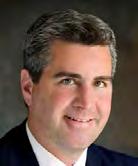
Economic forecasts are a bit like New Year’s resolutions — hopeful optimism for future success in areas that one struggled with in the past. For the construction industry, the hope is that 2023 will bring an increase in owner confidence to invest in construction projects, lower interest rates to make project financing possible, leveling of material prices and availability to minimize bid price increases and material delays, and an ample supply of employees, willing and able to work building Wisconsin.
In 2022, U.S. total construction starts rose 11% (through September) with increases in all major sectors: private residential 13%, private nonresidential 11%, and public sector, including transportation, 7%. The Architectural Billing Index for September reflects that architectural billings are up slightly over 2021, a good sign of new projects to come, and the Dodge Momentum Index is up over 25% from October 2021. Manufacturing, water supply, and commercial construction saw the largest increases in 2022 with power, office, and transportation at levels lower than or equal to 2021. As historical trends demonstrate, growth in the different construction segments can vary widely each year. In 2023, federal funding is anticipated to spur growth in some markets that were down this past year.
Transportation, manufacturing, and energy projects are forecasted to be strong in 2023 due in part to three major investments made at the national level. The Infrastructure Investment and Jobs Act (IIJA) signed in November 2021 authorized an additional $550 billion above baseline infrastructure
spending to fund the interconnected transportation network and supports expansion of broadband, bridge repair, and clean energy transmission and power upgrades. The Chips+ Act funds investment in domestic manufacturing of semiconductors. The Inflation Reduction Act of 2022 includes a major expansion of tax credits (and direct payments to municipalities, non-profits, and tribes) for investment in projects that increase energy efficiency and reduce carbon emissions.
Despite the ongoing concerns about a housing shortage, particularly for accessible housing, it is forecasted that both multi-family and single-family housing will fall for at least the first half of 2023 due to rising interest rates. The post-pandemic shift from retail to e-commerce and office work to employee preference for hybrid work leaves ongoing uncertainty in the retail and office sectors but leads to increased demand for e-commerce/distribution and decentralized office locations.
The availability and cost of building materials in 2022 was particularly challenging for contractors as they strived to keep bid price increases at a minimum. Between April 2020 and September 2022, steel increased 91%, plastic construction products 56%, and copper and brass mill shapes 54%. While these increases in construction inputs are remarkably high, the good news is that the prices have been rapidly falling since Q1 of 2022, giving optimism to contractors and owners alike. While material costs and supply chain challenges increased between April 2020 and April 2022, they are stabilizing; unlike the challenge of
finding workers. Wisconsin, like the rest of the Midwestern states, has close to no population growth, making worker shortages once again the #1 challenge for construction, and every other industry.
Wisconsin’s construction industry contributes not only to the quality of life we enjoy but is an important stimulator for the economy. Every $1 spent within the construction industry produces an economic impact of $1.81. Every $1 million spent within the construction industry generates 12 jobs on average (7 within construction and 5 in other sectors) and over $690,000 in wages. We look to 2023 with optimism and are prepared to work with other industry leaders as we Build Wisconsin Together.
The Construction Business Group promotes and protects the construction industry We ensure fair contracting laws are followed on public construction projects. We work cooperatively with contractors, employees and public entities by educating them on fair contracting laws, monitoring projects for fair contracting compliance, and identifying and helping to resolve compliance issues.
Construction Business Group
Wisconsin, like the rest of the midwestern states, has close to no population growth, making worker shortages
once again the #1 challenge for construction, and every other industry.
“ ”
WBA W
JAN. | FEB. | 2023 | WISCONSIN BANKERS ASSOCIATION | 19
ISCONSIN E CONOMIC R EPORT
ISCONSIN E CONOMIC R EPORT
It’s often said, you have to be an optimist to be a farmer. While there is a lot to be thankful for as we head into 2023, there are also a lot of concerns lingering for Wisconsin farmers who experienced a year of great turmoil and change. But alas, it’s time to look ahead to a new year.
The past year brought a war in Ukraine, severe drought pockets in the western portion of the U.S., intense market volatility, as well as inflation that we haven’t experienced in 40 years. These have drastically complicated the commodity markets in the U.S.
At the farmgate, we have seen increased prices for the commodities we produce, but like other industries, we also experienced increased costs for everything from tractor parts to seed and fertilizer. In general, there is optimism for 2023 because of the global demand for products, but there also is skepticism among farmers.
Farmers are good at controlling what we can control. Many farmers use forward contracts on both production and purchased inputs or protect their margins through insurance or hedging. Through good management, we also need to nurture our crops and care for our livestock. Balancing business needs is a major focus and seems to get more complicated by the year.
According to the U.S. Bureau of Labor Statistics, the current annual inflation rate for the U.S. for the 12 months ending October 2022 stands at 7.7%. Generations of farmers have not experienced rates at this level. Add to that the supply chain challenges that have affected equipment purchases and building expansions, and we have some large stress points within the agricultural community.
Higher interest costs and current land prices also make it challenging for
Wisconsin Farm Bureau Federation
Wisconsin Farmers Continue to be Cautiously Optimistic
By Kevin Krentz, WFBF President

beginning farmers to enter the industry, which will continue the trend of consolidation.
Like many other industries, another issue farmers and agribusinesses face is a severe lack of employees. The BLS also reports that Wisconsin’s October unemployment rate was at 3.3%. Labor shortages will continue to drive innovation and automation as farms find ways to become more efficient with limited workers. Once politics settle, a focus on immigration reform will be revisited.
Our state’s farmers not only supply locally but are a large part of the global food supply.
Farm Bureau has long advocated for reducing trade barriers globally and will continue to do so. The current geopolitical environment will continue to change our trade maps moving forward, but U.S. farmers can compete with other global food producers when presented with barrier-free trade.
On the consumer front, food prices are constantly a focus and talking point. Some of the higher costs at the farm level are being passed to customers at the grocery stores. This is driving the demand for certain products and consumers wanting to know where and how their food is grown and raised.
Within the consumer conversation, we are continuously evaluating our practices when it comes to conservation. However, in order to be sustainable, we cannot regulate farms out of business. Farmers must be able to afford to adapt to the ever-changing government regulations and industry requirements while being able to try new things that might better our resources. Wisconsin farmers are some of the most progressive at this throughout the country. We have
Wisconsin agriculture consists of 64,100 farms on 14.2 million acres and annually contributes $104.8 billion to our state’s economy.
made great progress and will continue to lead innovation.
Wisconsin agriculture consists of 64,100 farms on 14.2 million acres and annually contributes $104.8 billion to our state’s economy. Much of which is spent within the state’s rural communities.
Wisconsin Farm Bureau has advocated for farmers for more than 102 years and as farming continues to adapt to feed the world, Farm Bureau will continue to adapt to support our farmers.
Every year, through our grassroots process, Farm Bureau voting members at the county level bring forth policy that guides our organization at the local, state, and national levels on issues affecting our members. There is no shortage of topics to be discussed for our farmers.
As a new year and political cycle begin, you can expect many of these topics to be discussed.
There is optimism for the new year because, by nature, farmers are hopeful people. We will see what the truth holds in the next 12 months as 2023 unfolds.
Wisconsin Farm Bureau Federation is the state’s largest general farm organization, representing farms of all sizes, commodities and, management styles. There are more 46,000 members that belong to WFBF. Voting Farm Bureau members annually set the policy the organization follows, and are involved in local, state, and national affairs, making it a true grassroots organization.
W
20 | WISCONSIN BANKERS ASSOCIATION | JAN.|FEB.|2023
“ ” WBA
Wisconsin Manufacturers & Commerce The New Malaise
By Kurt R. Bauer, WMC President and CEO

2022 felt a lot like the Carter years of the late 1970s. That period was marked by runaway inflation, spiking interest rates, high crime, energy insecurity, and the Cold War. Add to the mix a lingering governmental legitimacy crisis caused by Watergate, and the blow to both our national psyche and international prestige caused by the Iranian hostage crisis (and the failure of the Desert One rescue mission).
All of the above created a widespread belief that America was in decline.
I see a lot of parallels to what happened then and what is happening now. For example:
» Inflation is the highest it has been since the 1970s;
» Interest rates are rising;
» Crime is rampant in big cities;
» The cost of energy is way up and its reliability is in question;
» We face a new Cold War with not only Russia, but with China as well;
» Distrust in government and other institutions is way up; and
» We saw an incredibly chaotic U.S. withdrawal from Afghanistan.
The difference between 40 years ago and now is that many of the problems we face today are self-inflicted by wrongheaded policies. When President Carter gave his “malaise speech” in 1979, the U.S. didn’t have the technology to affordably extract oil and gas from the vast deposits of shale found in North America, which meant we were at the mercy of the Organization of the Petroleum Exporting Countries (OPEC).
Hydraulic fracturing changed all that and as a result, the U.S. was a net exporter of oil and gas in 2019
and 2020. But, not today because the Biden Administration’s energy policy is to rapidly (I would argue recklessly) transition away from fossil fuels by thwarting the investment, exploration, extraction, refinement, and transportation of domestically produced coal, oil, and natural gas. As a result, energy prices are rising, which drives inflation because energy is the common ingredient in everything that is made, grown, and transported. That is why energy is often referred to as the master resource. Without reliable and affordable energy, countries cannot prosper. The U.S. is no exception.
What we are doing is unprecedented. In the history of the world, I can’t think of another nation that had access within its borders to an incredibly valuable natural resource, but decided not to use it. Instead, the U.S. is begging other nations, including unfriendly and/or autocratic regimes like Venezuela and Saudi Arabia, to sell us the energy we are capable of producing ourselves. Not to mention that the U.S. is dependent on China for the production of much of what goes into or otherwise constitutes “green” energy, like batteries, wind turbines, and solar panels.
Looking ahead, I am not optimistic because if you keep doing what you are doing, you are going to keep getting what you got. According to Gallup, 81% of Americans said before last fall’s mid-term elections that they were dissatisfied with the direction of the country. Despite that, President Biden’s party performed unexpectedly well, which will embolden him to stay the course.
As a result, energy inflation could very well tip the U.S. into a recession in
W ISCONSIN E CONOMIC R EPORT
“ ”
2023. It will certainly continue to hurt Wisconsin’s two signature industries — manufacturing and agriculture — because both consume a lot of energy.
Oddly, the saving grace may be the workforce shortage. As has been well documented, Wisconsin has a demographically induced labor shortage caused by a combination of several decades of below replacement birthrates and outmigration patterns.
I recently asked an economist from the Federal Reserve Bank of Chicago if there can be a recession without a spike in the jobless rate. The economist smiled wryly and answered with an emphatic no. So even with high inflation, tangled supply chains, and rising interest rates, unemployment in Wisconsin is only 3.3%, up slightly from a record low of 2.8% last spring.
It’s a paradox. The labor shortage is keeping many Wisconsin businesses from growing, but it may also help buoy the economy in a downturn.
Founded in 1911, Wisconsin Manufacturers & Commerce (WMC) is the combined state chamber of commerce, state manufacturers’ association, and state safety council. With nearly 3,800 members, WMC is Wisconsin’s largest business association representing employers of all sizes and from every sector of the economy.
WBA
Without reliable and affordable energy, countries cannot prosper. The U.S. is no exception. JAN.|FEB.|2023 | WISCONSIN BANKERS ASSOCIATION | 21
WBA
ISCONSIN E CONOMIC R EPORT
For grocers, it has been an incredible gauntlet from the beginnings of the pandemic in 2022 to the peek over the 2023 precipice.
The challenges created for grocers and their suppliers as the pandemic lodged itself into the daily business operations have only continued to create hurdles for the industry.
As most grocery store shoppers know, not all shelves are full of their favorite products — shoppers have had to deal with substitutes or alternatives.
Throughout all these topsy-turvy, head-spinning challenges, there is one common denominator that bears most of the blame for what drives grocers crazy. Workforce.
Simply put, there are not enough people available to fill the jobs open today, nor in the years to come. Reports have suggested the workforce population in Wisconsin is flat and likely to decline. Forward Analytics notes Wisconsin’s youth population has declined 4.3% since 2010 and says a decline in the state’s under-18 population will causes economic problems. That same report forecasts that by 2030, the working population will be down by 130,000 people.
Grocers, convenience stores, and retail businesses report there simply is not a pool of people in the workforce that can fill the gaps. And, for those who want to suggest otherwise that all is good because unemployment is low and UI applications are down, that’s not necessarily the case.
There are all sorts of reasons why the workforce is running on empty. During the pandemic, people chose not to work; were let go by employers who
Wisconsin Grocers Association
It’s the Workforce, Duh
By Brandon Scholz, WGA President and CEO

couldn’t keep their doors open; received state and federal assistance to make up for their non-employment status; as well as other factors.
Confounding the employment factor is the regressive impact of inflation that has chewed up most all the incredible and eye-popping increasing in wages and benefits.
Rolling into 2022, with the government giving assurances that the economy was in good shape (inflation not withstanding), the expectations were that people would come back to their jobs, or any job.
Not so. Didn’t happen. Not only did people not show up, but the pool of prospective employees was more like a very small pond.
The forecast for 2023 doesn’t look much better. You may find grocers taking down a checkout lane and adding a self-checkout stand to help their customers move through the end of their shopping experience.
What’s the solution? Wisconsin needs to bring people back to Wisconsin to work here. The question is how.
Let’s target quality of life issues in Wisconsin and focus legislative, employer, and community efforts on several key areas. Good businesses, strong communities, safe streets and less crime, daycare, housing, public transportation, and good schools are key components of attracting new workers to Wisconsin.
These changes will require funding solutions, regulatory relief, and legislative initiatives in local, county, and state governments.
Grocers and their customers are resilient. They’ve proved it since the
Grocers and their customers are resilient. They’ve proved it since the pandemic started. It doesn’t mean that things are hunky dory, but we’re approaching critical mass. Changes must be made to solve our workforce crisis.
pandemic started. It doesn’t mean that things are hunky dory, but we’re approaching critical mass. Changes must be made to solve our workforce crisis.
Winsight Grocery Business notes that inflation, technological advances, and the pandemic have influenced grocery shopper habits. It’s a common sight to see shoppers using smartphones to look up sales, product information, loyalty apps, and more.
While these changes have become common place for the customer, they are not long-term solutions for the retail world.
It starts with the workforce and quality of life.
The Wisconsin Grocers Association represents nearly 1,000 independent grocers, retail grocery chain stores, warehouses and distributors, convenience stores, food brokers, and suppliers. Wisconsin grocers employ over 50,000 people with more than $1 billion in payroll and generates more than $12 billion in annual sales in Wisconsin resulting in approximately more than $800 million in state sales tax revenue.
Visit wisconsingrocers.com
“ ”
22 | WISCONSIN BANKERS ASSOCIATION | JAN.|FEB.|2023
W
Wisconsin Technology Council

Recession or No, Wisconsin Tech Sectors Can Move Ahead in 2023
By Tom Still, WTC President
Call it the “Great Reset.” After years of predictably robust growth, technology stocks rebooted in 2022 and disrupted public markets all the way down. The question is whether technology stocks — specifically, Big Tech — will climb back in 2023.
The answer is “probably,” but not right away. Both the Nasdaq-100 and the S&P 500 are tech-heavy at the top, and 2022’s major value rundowns took place as the tech industry came to grips with
Wisconsin has yet to adopt a plan for how to place more electric vehicle charging stations. It’s currently 43rd out of 50, according to Governing magazine.
too much growth, too fast. Much of that pain may be past. Moreover, tech stocks historically do well in the recovery phase of a recession rather than leading up to one.
The Wisconsin economy is increasingly intertwined with what’s happening in tech markets. Companies such as Microsoft, Amazon, Google, and Tesla all have a presence in the state in one form or another, especially with the advent of remote work. That neighbor who you thought was a stay-at-home mom may well be a software coder.
Whether it brings a full-fledged recession or an economic course correction, the year ahead is a time to seize opportunities to make Wisconsin
even more open to tech-based businesses and workers. Some examples:
» Wisconsin should take the next step in seeding the clouds for a privatepublic “fund of funds.” Out-of-state venture capitalists are increasingly finding solid deals in Wisconsin; earlier state pump-priming is working; the research base is here; and a huge state budget reserve should create room for a state investment that levers private dollars. Out-of-state investors will continue to be attracted by strong deals, but also by the state’s willingness to show confidence in its own startup expertise.
» Wisconsin is positioned to take advantage of changes in energy and other technologies that can make the world more resilient in the face of climate change. Innovation in solar and wind energy will continue — so long as the grid keeps up with the demand. Storage technologies are a sweet spot; nuclear fission and fusion may help in the long run; some industries see a future in hydrogen energy; and the state is a center for freshwater technology innovation. Can migrating “climate refugees” to fill workforce holes be too far off?
» With better incentives, the state could see an influx of industrial research, data centers (which use a lot of water, by the way), and even video game development. The Columbus, Ohio, region won the Intel semiconductor production fight, but there may be more chip-making chances to come.
» There are myriad ways to mess things up, of course. Beating up the healthcare industry over costs alone
ISCONSIN E CONOMIC R EPORT
“Whether it brings a fullfledged recession or an economic course correction, the year ahead is a time to seize opportunities to make Wisconsin even more open to tech-based businesses and workers.
is a bad strategy in an era when people move for jobs and lifestyle, which includes high-quality health care. Not recognizing the economic value of higher education is a similar mistake. If there’s one thing about the Minnesota economy that makes it more attractive to site selectors, it’s the significantly higher percentage of people with post-high school degrees. Wisconsin also has yet to adopt a plan for how to place more electric vehicle charging stations. It’s currently 43rd out of 50, according to Governing magazine. Finally, don’t scrimp on the state’s research and development future by making it too hard to build academic science and engineering buildings. When Wisconsin delays, its competitors forge ahead.
The Wisconsin Technology Council is the independent, non-partisan science and technology advisor to the governor and the Legislature.
“ ” ”
WBA W
JAN.|FEB.|2023 | WISCONSIN BANKERS ASSOCIATION | 23
Wisconsin REALTORS® Association
Housing Market Slows as Demand Cools and Inventory Remains Tight
By Michael Theo, WRA President and CEO With insights from Dave Clark, economist with Marquette University

After two straight years of record home sales, the Wisconsin existing home market slowed significantly in 2022. This was a result of both declining demand and continued weak housing supply. Demand slowed in part because the economy weakened slightly in the first half of the year. Specifically, the real (inflation adjusted) GDP fell 1.6% in Q1 of 2022, and it slowed 0.6% in Q2 before rebounding by 2.9% in the third quarter. Still, the labor market remained at full employment which
The Fed has indicated that it intends to keep raising short term rates until inflation is under control, even if its actions lead to a recession.
likely presented the National Bureau of Economic Research from classifying the slowdown as an official recession. What really slowed demand was the rapid decline in housing affordability. In October of 2021, a Wisconsin buyer with median family income qualified to buy 201% of the median priced home in the state, assuming a 20% down payment and the remainder financed by a 30-year fixed-rate mortgage at the rates that existed at that time. Just 12 months later, that same buyer would only qualify to purchase 136% of the median priced home. Although median family income was estimated to have grown by 6.2% over that 12-month period, that was offset by a 6.1% increase in the median housing price, and a more than doubling of the 30-year fixed rate mortgage, from
3.07% in October 2021 to 6.90% in October 2022. Weakness on the supply side only exacerbated the problem with total listings in October 2022 down 24% compared to that same month in 2021. Overall, through the first 10 months of 2022, home sales were off their 2021 pace by 11.2%. Even though sales have weakened significantly, this remains a strong sellers’ market with just 2.6 months of available supply in October 2022, which is well below the six-month benchmark that signals a balanced housing market.
One reason the mortgage rate rose so quickly is because inflationary expectations, which lenders must consider when extending long-term credit to homebuyers, have increased in the past year. That is, inflation is no longer viewed as transitory. As a result, the Fed has taken decisive action to slow the economy and reduce inflation. The Fed’s primary tool to slow inflation is to increase the short-term federal funds rate, which is the rate that member banks lend to each other to cover overnight reserve shortfalls. Specifically, the upper limit of the federal funds target range rose from near zero (i.e., 0.25%) at the beginning of 2022 to 4% by early November. The good news is that there has been some slight improvement in headline inflation, which peaked in June 2022 at 9.1% and fell to 7.7% by October. Hopefully that trend continues. Still, inflation remains well above the Fed’s target inflation rate of 2% and the Fed has indicated that it intends to keep raising short term rates until inflation is under control, even if its actions lead to recession. Given that the U.S. and Wisconsin labor markets are currently at full employment (i.e., both were under 4% in October), we expect the Fed to
“ ”
Clearly the Fed is committed to controlling inflation, but Congress and the Biden Administration need to avoid exacerbating the inflation problem through irresponsible spending practices.
continue its upward movement of the federal funds rate. Until inflationary expectations are lowered, mortgage rates will remain elevated and affordability will remain low. This, combined with tight inventories, will constrain the housing market in 2023.
Nationally, policymakers need to maintain their focus on the inflation problem. Clearly the Fed is committed to controlling inflation, but Congress and the Biden Administration need to avoid exacerbating the inflation problem through irresponsible spending practices. While there is little that local policymakers can do to stimulate the demand side of the housing market, they can help set the stage for new construction once the housing sector begins to improve. This includes lowering the regulatory burden and helping to foster growth in training in the building trades.
Founded in 1909, the Wisconsin REALTORS® Association (WRA) is one of the largest trade associations in Wisconsin. It represents and provides services to more than 17,500 members statewide WRA’s goal is to promote the advancement of real estate in Wisconsin and provide cutting-edge tools to help REALTORS® enjoy a successful career and be competitive in their market.
“ ”
24 | WISCONSIN BANKERS ASSOCIATION | JAN.|FEB.|2023
WBA W ISCONSIN E CONOMIC R EPORT
CEO Economic Forecast: Cloudy with a Chance of Recession WBA releases results of
In the Wisconsin Bankers Association’s (WBA’s) biannual Economic Conditions Survey of Wisconsin bank CEOs, three quarters of respondents rated Wisconsin’s current economic health as “excellent” or “good ” This continues a trend from the mid-year 2022 survey, when 71% of survey respondents gave “excellent” or “good” ratings. None of the Wisconsin bank CEOs who completed the most recent survey foresee major economic improvement in the first half of 2023 — 28% predict that the economy will stay the same and 72% predict it will weaken in the next six months.
“Because they are in tune with the financial circumstances of businesses and families in their areas, bank CEOs are experts who can apply a lot of context to their economic perspective,” said WBA President and CEO Rose Oswald Poels. “With the likelihood of a recession in the coming year looming, banks are standing ready to help their customers and communities through.”
Among the economic bright spots cited by CEOs in the survey were high employment, continued spending by consumers, the housing market, and business growth — particularly in manufacturing, agriculture, and service/tourism. Top economic concerns reported by bank CEOs were inflation, the likelihood of recession, rising interest rates/slowed loan growth/reduced ability of borrowers to repay loans, business staffing, cybersecurity/fraud, and inability to access childcare.
Bank CEO Economic Conditions Survey



Economic Conditions Survey JAN. | FEB. | 2023 25
Highlights from the End-of-Year 2022 Bank CEO Rise (24%) Fall (51%) Stay about the same (25%)
wisbank.com/22survey
Read the full report at
.
The end-of-year 2022 survey was conducted November 15–30 with 71 respondents. Please visit wisbank.com/22survey to read the full report. Excellent (6%) Good (69%) Fair (24%) Poor (1%) Unlikely (3%) Neutral (10%) Likely (62%) Very likely (25%)
Invisible
Credit
(continued from p. 1)
in the U.S. are considered unscorable. Defined as one’s lack of credit history and score, credit invisibility often results in difficulty accessing credit products. Unscorability, on the other hand, defines the limited information one has in their mainstream credit file and therefore their lack of ability to generate a conventional credit score.
The CFPB highlights that not only are a disproportional number of credit invisible
We are nearing the point where we can say — no matter who you are, where you live, or what part of your financial journey you’re on — that we can score you and help you access the financial services you need.
— Greg Wright executive vice president and chief product officer Experian Consumer Information Services



customers located in lowincome neighborhoods, but that around 15% of Black and Hispanic consumers are credit invisible in comparison to only around 9% of white customers.
However, as 90% of the top lenders throughout the U.S. require at least six months of recorded credit activity, according to the credit bureau Experian, credit invisible consumers often do not have access to reliable means to establish and expand their credit. With minimum balance requirements and fees being cited within the top five reasons as to why 4.5% households in the U.S. remain unbanked, according to the Federal Deposit Insurance Corporation’s (FDIC) 2021 FDIC National Survey of Unbanked and Underbanked Households report,
it is critical that bankers find alternative solutions for those looking to expand their opportunities, meet their financial goals, own a home, or simply begin their financial journey.
Providing Accessible Credit
Lack of access to mainstream financial services or other low-cost credit products often does not stop individuals from borrowing or seeking certain forms of financial assistance. In fact, this may inadvertently cause one to engage in highcost, potentially predatory lending cycles.
“Banks throughout America play an important role in not only providing opportunities for consumers to access traditional credit services, but also in assisting individuals to establish and maintain their credit,” says Jeff Langkamp, vice president — chief compliance officer at Bank Five Nine in Oconomowoc. “Having no credit score most likely means that individuals will have to pay a higher interest rate or use payday lenders who charge outrageously high interest rates. Additionally, establishing a credit score to purchase a house or car allows families to build generational wealth.”
To bankers, providing access to credit may mean offering secured credit
cards or developing a credit invisible loan program, which involves making smaller loans to invisibles to gradually build their scores or looking beyond the standard evaluation producers to aspects such as their residency and employment stability.
At Bank Five Nine, customers have access to the Achieve Credit Builder™ program, an account certified as meeting the Bank On National Account Standards. The product, according to Langkamp, helps individuals establish or repair their credit at little to no cost.
“The average age of our customers that are taking part in the credit builder program is 26, so the product is helping younger individuals as they begin their credit journey,” highlights Langkamp.
Positioning Consumers for Success
In December 2022, Fannie Mae announced that it would be strengthening its underwriting program Desktop Underwriter® to responsibly expand eligibility and further simplify the borrowing process for individuals without credit scores.

“Traditional lending practices make it hard for borrowers with no credit score to access credit,” said Malloy Evans, executive vice president and head of single-
family business, in the press release published on December 6.“[As a result,] Fannie Mae has taken steps that may help them responsibly qualify for a home loan using data that provides a more holistic view of how they manage their money.”
The enhancements released by Fannie Mae update existing eligibility criteria to permit standard loan-to-value (LTV), combined loan-to-value (CLTV), and high credit loan-to-value (HCLTV) ratios on certain properties and expand the standard maximum allowable debt-to-income ratio to 50%. Additionally, the organization has created an automated option for documenting nontraditional credit sources to simplify the process for both the lender and the borrower.
A significant component of this update also includes allowing borrower-permissioned data that consider a borrower’s transaction patterns and balance trends.
Embracing Alternative Credit Data
As many banks and businesses across the U.S. look to alternative ways to promote financial capability among all consumers, many are looking to consumer-permissioned data. Experian defines alternative credit as expanded Fair Credit Reporting Act




(continued on p. 27)
26 JAN. | FEB. | 2023
Banks Serve Communities with Invisible Credit in an Effort to Develop Financially Capable Consumers
Invisible Credit
(continued from p. 26)
(FCRA)-regulated data. This data often includes rental payments, small-dollar loans, and consumer-permissioned data.
“Each individual situation is different; the most important thing is finding a plan that fits the needs and financial goals of the individual,” emphasizes Langkamp. “In addition to resources like Achieve Credit Builder™, our bank encourages our customers to take advantage of self-reporting opportunities like rental housing, and other payments that may not be reflected on a credit report.”
As establishing good credit remains a critical component of one’s ability to acquire wealth, self-reporting has quickly become an integral aspect in assisting individuals to easily establish a credit score.

Each individual situation is different; the most important thing is finding a plan that fits the needs and financial planning goals of the individual.
— Jeff Langkamp vice president – chief compliance officer Bank Five Nine, Oconomowoc


In an effort to make credit accessible to all communities, Experian has developed free resources for consumers to utilize as they develop their credit score. Experian Go™ provides individuals with education and insights unique to their credit journey. Experian Boost™ allows consumers to connect their bank account or credit card to their Experian credit file. By making on-time payments,
individuals can highlight their good spending habits and raise their credit score.
“By using expanded data sources and better analytics in credit decisions, banks can help more consumers gain access to credit while making more informed decisions,” says Greg Wright, executive vice president and chief product officer for Experian Consumer Information Services. “This is a win for both lenders and consumers — and it’s just the right thing to do.”
Wright adds that score models used today have historically left nearly 50 million Americans living with a limited credit history locked out of the credit ecosystem. “Leveraging expanded data sources and advanced analytics can help change this narrative,” he emphasizes.
While credit invisible and
unscorable individuals remain a significant portion of our communities, there are many opportunities for banks to assist. Whether it be offering low-cost products and secured credit cards or encouraging consumers to utilize resources that educate them on their individual credit journey, bankers play a major role in promoting financial security for generations to come.
“This is an exciting time for the banking and financial services industry,” concludes Wright. “By leveraging the right tools, we are nearing a point where we can say — no matter who you are, where you live, or what part of your financial journey you’re on — that we can score you and help you access the financial services you need.”
Flanders is WBA writer/editor.
JAN. | FEB. | 2023 27 WE PROTECT YOU from the Unexpected Professional/Specialty Lines • Financial Institution Bond • Directors & Officers Liability • D&O Civil Money Penalties • Cyber Liability • EFT Guard • Excess Deposit Bond Property & Casualty Lines • Property & Casualty • Foreclosed Property • Workers Compensation • Umbrella Liability Lending Related Lines • Master Property (Force Placed) • Mortgage Protection • Lenders Single Interest • Flood Compliance Solutions www.mbisllc.com Jeff Otteson Vice President of Sales jeffo@mbisllc.com 608.217.5219 Melissa Noonan Account Manager melissan@mbisllc.com 608.441.1275 Contact Us!
WBA is Accepting Nominations for the Wall of Excellence

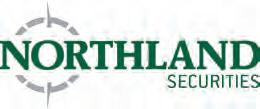
With the Wall of Excellence officially installed in the Engagement Center at the Wisconsin Bankers Association’s (WBA) headquarters building, WBA has proudly honored three classes of Leaders in Banking Excellence at celebrations held in 2021 and 2022.

The WBA Leaders in Banking Excellence celebrates exceptional bankers from throughout Wisconsin’s history. Through this program, current and former banking leaders who have helped shape our state’s banking industry are honored with recognition as a fixture on the Wall of Excellence. Your honoree’s plaque will give today’s
bankers a glimpse of those who have made our industry what it is today.
The WBA is accepting nominations from now through May 12, 2023 for the fourthyear class of the WBA Leaders in Banking Excellence.
To nominate a banker for this honor, please visit wisbank.com/excellence and complete the application form, or contact WBA’s Rose Oswald Poels at 608-441-1205 or ropoels@wisbank.com for more information.
To nominate a banker as a Leader in Banking Excellence

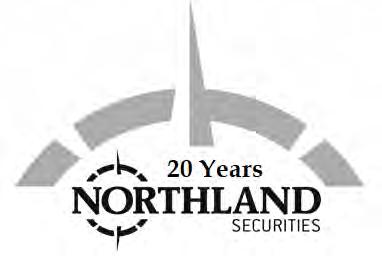
please visit wisbankcom/ excellence and complete the nomination form by May 12, 2023.
WBA Leaders in Banking Excellence, 2020–2022:

Paul C. Adamski • Jon Bernander James K. Caldwell • James S. Dolister • The Eager Family • Thomas F. Farrell • Robert Gorsuch
• Robert J. Just, Jr. • John F. (Jack) Kundert • Debra R. Lins • E.David Locke • Richard (Dick) Pamperin • John K. Reinke • Lee J. Schmalz • Steven R. Schowalter • Frederick F. Schwertfeger
• Jerry Smith • Mary L. Staudenmaier • John Godfrey Thomson
• Thomas M. Tubbs • James B. Wigdale • Merlin Zitzner
•
•
•
•
•
•
Portfolio Analytics
Portfolio Accounting
Municipal Bond Credit Support
Asset Liability Management Reports
Staff with depth and experience
Leading Underwriter of Upper-Midwest Bank Qualified Municipal Bonds (Source: Bloomberg League Tables Annual Rankings) At Northland, our mission is providing direction and producing results toward our clients’ goals. We are trusted professionals in the business of investing Financial Institution portfolios. THANK YOU for your consideration! RC 22-639 Muni 22- 549 1222 Partn ering with community banks for over 20 years Visit NorthlandSecurities.com Two offices in Wisconsin to serve your bank: 2675 N. Mayfair Road, Suite 550 Milwaukee, WI 53226 414-727-2229 958 Liberty Drive, Suite 202 Verona, WI 53593 608-476-6001 800-851-2920 | Member FINRA / SIPC | Registered SEC / MSRB April 25, 2023 Glacier Canyon Lodge & Convention Center 45 Hillman Road | Wisconsin Dells or Virtual Save theDate InvestinYour WomenLeaders. women in banking conference
Send your bank’s top performing women to the WBA Women in Banking Conference as an investment in their futures with your bank. Invest in Your Women Leaders
»
An opportunity to honor Wisconsin’s excellent bankers
28 JAN. | FEB. | 2023
The WBA Engagement Center displays the Leaders in Banking Excellence plaques honoring exceptional bankers throughout Wisconsin’s history.
Thank
By Daryll J. Lund
for Choosing WBA EBC in 2023
In 1982, the Wisconsin Bankers Association Employee Benefits Corporation, Inc. (WBA EBC) was formed to provide flexible, high-quality health benefits and insurance coverage exclusively to members of the Wisconsin Bankers Association (WBA).
As our corporation moves into its 41st year, I thank each WBA member bank that has entrusted our team with their insurance needs.
As our organization continues to expand, it remains a top priority of our team to ensure that WBA members receive the options and preferred pricing that is typically reserved for large employers. Since 2018, WBA EBC has offered a statewide Association Health Plan (AHP) to all
Association Update
Daryll J. Lund »
members. The AHP, administered by UnitedHealthcare (UHC), has saved WBAmember banks over $2.1 million in the last five years. By spreading the risk over large numbers we have been able to help nearly 50 banks and over 2,200 members.
By joining the WBA AHP, bankers enjoy benefits such as working with a dedicated, local association team; opportunities for cost savings; more plan options; a strong national network; and
Contact EBC’s Brian Siegenthaler at 608-441-1211 or bsiegenthaler@ wisbank.com to learn more.
convenient resources.
Whether your bank is looking to add coverage to dental, medical, prescription drug, vision, or life and disability — WBA EBC is the one-stop-shop in providing your employees with affordable, high-quality benefits for their well-being. Additionally, WBA EBC’s online portal allows for member-driven control of enrollment or changes, provided transparency with costs and expenses, as well as ensured banks have
the ability to control administrative costs in the future.

Thank you to the 100+ banks throughout the state that have chosen the WBA-EBC for their insurance programs for 2023. With your enrollment, nearly 4,000 members have gained access to affordable insurance. WBA EBC Vice President Brian Siegenthaler, our dedicated team, and I look forward to continuing to provide flexible plans and wellness solutions to you and your employees.
Please visit wisbankins.com or contact Brian Siegenthaler at bsiegenthaler@wisbank.com or 608-441-1211 to learn more about the advantages we offer.
Lund is WBA executive vice president – chief of staff and president of EBC and MBIS.

You
Bankers insure locally with trusted
Happy Holidays Wishing you a happy and healthy New Year! Thank you for your loyalty and goodwill throughout the year.
professionals
JAN. | FEB. | 2023 29
Community Advocate Spotlight

Wisconsin’s bankers are the definition of “community advocates” in all that you do every day to improve your local economy through your bank’s products and services, as well as through your generous philanthropy of time and money. This column shares and celebrates the diverse backgrounds, experiences, perspectives, and innovation of some of the extraordinary bankers in this state.
Q&A
The following is a brief interview between WBA President and CEO Rose Oswald Poels and Waldo State Bank President Tom Reil
Read past interviews at wisbank.com
Rose: How did you first get into the banking industry?
Tom: After graduating from University of Wisconsin-Oshkosh in 1983 with a degree in finance, I started my career in banking at First Wisconsin in Fond du Lac. It was a great starting point, but corporate banking was not for me. I then moved on to F&M Bancorp as a lender in their New London office for 12 years. Another great learning opportunity, but when the Bancorp was sold, it was time for a change.
An opportunity to move closer to home and run a true “community bank” became available at Waldo State Bank, and I have been here for past 22 years.
What is your favorite aspect of your role at your bank?
There are lots of things that I enjoy about working at the bank. For one, every day is different and the wide variety of things I get to be a part of is challenging — there is never a dull moment. My favorite part is working with customers; helping them come up with an answer to their financial questions or putting a loan package together for them is incredibly rewarding.
I also love it when people ask, “Where’s Waldo?” I kindly smile and tell them, “It’s where you want to bank!” That line never gets old and will usually generate a smile, and that’s what I like to do.
I have also enjoyed being involved in the Wisconsin Bankers Association (WBA) — it is the best way for bankers to be engaged in actively promoting community banking as well as building lifelong friendships with peers. I think it is a privilege to serve in any capacity that fits one’s career and personality — from serving on the WBA Board, to being on the Independent Community Bankers of America (ICBA) House Finance committee, or just attending WBA events — the benefit of being active cannot be overstated. You can also have a heck of a lot of fun doing it!
What do you wish the general public understood about the banking industry?
There is a significant difference between community banks and all other financial institutions — the communities we serve are the reason why we (community bankers) are here. We take the
time to sit and listen to our customers and understand their needs, we consider their unique situation and offer products and services that fit their needs, and we have the ability to tailor our services to our customers — not fit them into a one-size-fits-all solution.
In addition, the majority of our business comes from existing customer referrals. I wish the general public understood how our existing customers felt and that everyone has the opportunity to develop a relationship with a bank that they can bank on.
Where do you believe the industry’s greatest challenges are in the next three to five years?
There will always be challenges, and being able to adapt is what make community banks unique. I think changes in technology will the biggest challenges that community banks face. Keeping up with cybersecurity, changes in AI, and improvements in process are just a few that banks are considering.
Please describe your current role at your bank and share with us one of your more rewarding experiences (e.g., a time you had to go above and beyond to help a customer, a memorable customer interaction, stepping in to help the local community after a disaster, etc.).
As president of the bank, and with the experience I’ve had in the banking industry, I have been blessed with the opportunity to get to know a lot of extraordinary people. I enjoy being able to use those connections to bring people together to help one another. To see customers that you have helped over the years prosper is very gratifying.
When I took my first job at First Wisconsin, the president of the bank at the time told me not to get into banking for the money. If I would be satisfied with a job where I could provide for my family, be a respected member of my community, and make a difference — a career in banking would be for me. Those words of wisdom have guided me well and are advice that I continue to share with new leaders at the bank.
Oswald Poels is WBA president and CEO | ropoels@wisbank.com 608-441-1200 | Twitter: @RoseOswaldPoels
Do you know a banker who should be recognized as a Community Advocate for the work that they do? Nominate them today by emailing Rose at ropoels@wisbank.com!
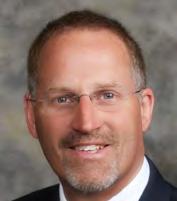 Rose Oswald Poels
Tom Reil
Rose Oswald Poels
Tom Reil
30 JAN. | FEB. | 2023
HELP WANTED
Chief Financial Officer
State Bank of Reeseville is seeking a qualified chief financial officer (CFO). This position will be in charge of navigating the bank through some of the most exciting transformations and advancements in their history!
The CFO will have oversight in many of the bank’s crucial operations such as asset and liability management, liquidity management, investment portfolio management, and debt and capital management. This position also plays a major role in assessing issues with our products, cost centers, the overall organization, and determine their financial impact, efficiency, and effectiveness.
Qualified candidates should have a successful mastery of the skills and responsibilities of a controller and cashier as well as 8 years of prior experience at a financial institution as a financial executive, regulatory advisor, accountant, investment agent, internal auditor, information technologist, as well as supervisory experience.
An MBA in accounting, finance, investment banking, or similar area of
Bankers Marketplace
wisbank.com/classifieds
Want to See More Ads?
Visit wisbank.com/classifieds to view a full listing of job postings or for more information on placing or responding to an ad.
study is required for consideration.
State Bank of Reeseville offers a competitive compensation package, continued training and education opportunities, great benefits, and an amazing team and work environment.
Please contact Jayne Adams, human resources director, at JayneA@ statebankofreeseville.com to view the full job description and apply!
Executive Vice President & Chief Lending Officer
Citizens State Bank of Loyal is seeking a qualified executive vice president & chief lending officer.
This position is responsible for the management of the loan department, including development and communication of policies and procedures, and overall responsibility for the growth and quality of loan portfolio. In addition, the chief
WISCONSIN BANKER
We promote a healthy environment for banks in Wisconsin through actively advocating, educating, and supporting our members.
Association Officers:
Daniel J. Peterson (Chair), President/CEO, The Stephenson National Bank & Trust, Marinette Donna J. Hoppenjan (Chair-Elect), President/CEO, Mound City Bank, Platteville
Alvaro Araque (Vice Chair), Senior Vice President, Director of Consumer and Private Banking, Johnson Financial Group, Racine
Kenneth D. Thompson (Past Chair), President/CEO, Capitol Bank, Madison Rose Oswald Poels, President/CEO, Wisconsin Bankers Association, Madison Association Board of Directors:
James R. Chatterton, President
National Exchange Bank & Trust, Fond du Lac
Paul A. Hoffmann, President/CEO Monona Bank
Ryan T. Kamphuis, President/CEO
Bristol Morgan Bank, Oakfield
Greg Lundberg, President/CEO
Fortifi Bank, Berlin
Jay C. Mack, President/CEO
Town Bank, N.A., Hartland
Thomas Mews, President
First National Community Bank, New Richmond
Paul J. Northway, President/CEO
American National Bank Fox Cities, Appleton
Greg A. Ogren, President/CEO
Security Bank Shares, Inc., Iron River
Joe Peikert, President/CEO
Wolf River Community Bank, Hortonville
Jennifer L. Provancher, President/CEO

The Equitable Bank, S.S.B., Wauwatosa
Daniel J. Ravenscroft, President/CEO
Royal Bank, Elroy
Teresa (Terry) Rosengarten, President/Chief Operating Officer
Unity Bank, Augusta
Wisconsin Banker is published bimonthly (six times per year) by Wisconsin Bankers Association, 4721 South Biltmore Lane, Madison, WI 53718; Telephone: 608-441-1200; wisbank.com Cassandra Krause, Editor Advertising: sales@wisbank.com 608-441-1216 ckrause@wisbank.com
To report a change of address, email us at requests@wisbank.com
The publication of advertisements does not necessarily represent endorsement of those products or services by the Wisconsin Bankers Association. The editor reserves the right to reject any advertising or editorial copy deemed unsuitable for publication for any reason. Copy deadline is eight business days before publication date.
Disclaimer: With the exception of official announcements, the Wisconsin Bankers Association disclaims all responsibility for opinions expressed and statements made in printed articles and advertisements in the Wisconsin Banker This publication is designed to provide accurate and authoritative information in regard to the subject matter covered. It is distributed with the understanding that the publisher is not engaged in rendering legal, accounting or other professional services. If legal or accounting advice or expert assistance is required, the services of a qualified professional should be sought.
lending officer is responsible for the functions associated with the credit risk management of the bank; identifying and understanding developing trends; and providing a thorough, independent assessment of a borrower’s capacity to withstand the risks posed by those trends through the preparation of written, in-depth analyses of business, management, and industry factors.
A primary component of this role will involve the exercise of independent judgement and discretion on matters pertaining to the identification and management of the credit risk and quality of the bank’s loan portfolio. This position is a member of the senior management team tasked with the responsibility of leading the bank in the absence of the CEO.
Interested individuals may contact Jasmine Gross at jgross@csbloyal.com to apply!
Senior Commercial Lender
At Northern State Bank, relationships rule. We understand that when our people succeed, our bank prospers.
We are, first and foremost, relationship bankers. Our senior commercial lender will maintain and
create new banking relationships. Our lenders underwrite good loans that assure continuance of our stellar asset quality — and we collect the loans we make. Our senior commercial lender will adhere to the bank’s policies and procedures and assist in the management of the commercial loan department. All our lenders are versatile — required to have a knowledge of other bank departments. We are one community bank team and we help out where and when needed.
Our senior commercial lender will be required to have a bachelor’s degree in finance, business, accounting, or economics and 5+ years of commercial lending and management experience.
Northern State Bank is an AAP / EEO employer We offer a competitive salary, an annual bonus, and a competitive benefits package. We understand and accept our employees’ work/life wants and needs.
Please contact John Beirl at jbeirl@ nsbashland.com with any questions and your interest in becoming a member of our team. We truly believe you will find yourself in our friendly bank environment… on the South Shore of Lake Superior.
JAN. | FEB. | 2023 31
WBA Mission Statement
A WBA Conference for Every Bank Leader
Make plans to join WBA and your banking colleagues for one or more of our many spring conferences!
Agricultural Bankers Conference | April 13–14
This conference brings together over 125 Wisconsin ag bankers for informative sessions and networking opportunities. This year’s conference speaker line up includes Dr. David Kohl from Virginia Tech. Get additional information online at wisbank.com/ag.
Women in Banking Conference | April 25
Invest in your women bank employees! Send your up-and-coming women bankers and top performers to this one-day conference to learn from industry experts and network with their peers. Over 225 bankers attended the conference in 2022, making it a memorable and motivational day for all attendees!
Human Resources Conference May 4
Planned by WBA HR Committee members, for bankers, by bankers, attendees can expect to join 50+ other banking HR professionals from across the state for a day of networking, education, and idea sharing.
BSA/AML Compliance Conference | May 10–11
This day-and-a-half conference brings together over 80 community banking BSA/AML compliance specialists for vital industry updates and educational content, as well as time for networking with your peers.
CFO Conference | May 17
The WBA CFO Conference returns as its own one-day conference in 2023! The day will be packed with valuable
educational presentations from industry thought leaders as well as time for networking with your banking peers.
Directors Summit | May 18
This summit discusses key issues in leadership and management of community banks from the director’s perspective. The event is beneficial for bank management teams, new or experienced directors, bank CEOs, executive officers, and bank general counsel.
Trust Conference | May 25

Planned with help from the WBA Trust Banking Section, this conference focuses on topics and regulations that directly impact trust and wealth management banking services. This is a must-attend event for trust banking professionals.
BOLT Summer Leadership Summit | June 15–16
Has your bank identified your emerging leaders? Are your next gen leaders ready? BOLT (Building Our Leaders of Tomorrow) is just what your bank’s emerging leaders need to learn and grow banking and leadership skills. The annual BOLT Summit is a great investment in your up-andcoming bankers' careers!
For additional details go to wisbank.com/education.
WISCONSIN BANKERS ASSOCIATION | 4721 SOUTH BILTMORE LANE | MADISON, WI 53718 | 608-441-1200 | www.wisbank.com Bank Executives CONFERENCE WBA FEBRUARY 8–10, 2023 Kalahari Resort & Convention Center, Wisconsin Dells wisbank.com/BEC ALL IN 32 JAN. | FEB. | 2023

























 » See the 2022 Gold Triangle Club members and 2022 BIGG Award winners on p. 7. Both groups, along with the Silver Triangle Club, will be recognized at the WBA Bank Executives Conference in February.
Bank Assets Total Banker Contributions
GOLD TRIANGLE CLUB LEVELS
» See the 2022 Gold Triangle Club members and 2022 BIGG Award winners on p. 7. Both groups, along with the Silver Triangle Club, will be recognized at the WBA Bank Executives Conference in February.
Bank Assets Total Banker Contributions
GOLD TRIANGLE CLUB LEVELS






















 WBA President and CEO Rose Oswald Poels honored three bankers at Bluff View Bank in Galesville for their lifetime of service to the banking industry. Pictured are (left to right): Dan Mueller, senior vice president – commercial & ag loan officer
Hayter
Tally-Brill
McGuire
Mickey
Kluck Hansen Allan
Paxton Johnson
WBA President and CEO Rose Oswald Poels honored three bankers at Bluff View Bank in Galesville for their lifetime of service to the banking industry. Pictured are (left to right): Dan Mueller, senior vice president – commercial & ag loan officer
Hayter
Tally-Brill
McGuire
Mickey
Kluck Hansen Allan
Paxton Johnson













 By Rose Oswald Poels, WBA President and CEO
By Rose Oswald Poels, WBA President and CEO
 By Eric Borgerding, WHA President and CEO
By Eric Borgerding, WHA President and CEO























 Rose Oswald Poels
Tom Reil
Rose Oswald Poels
Tom Reil

